March 2016 System Upgrades
Published Date : April 4, 2016
Dear kpi.com users,
We are delighted to announce that KPI.com has launched its monthly upgrades. Improvements are made in the Project Management, Accounting, CRM, HRMS, Payroll modules, as well as in the overall performance of the system. We put our best effort to develop existing features of the system and add new features according to our customers’ feedback and requests. We greatly appreciate your patience, understanding and goodwill as we do our best to improve the system overall, implement new features, and resolve the appeared issues as soon as possible.
My Workspace
- Holiday and Timeslot history log on My/Peer updates added;
History logs boxes added to Workspace to see the latest changes that have been made.
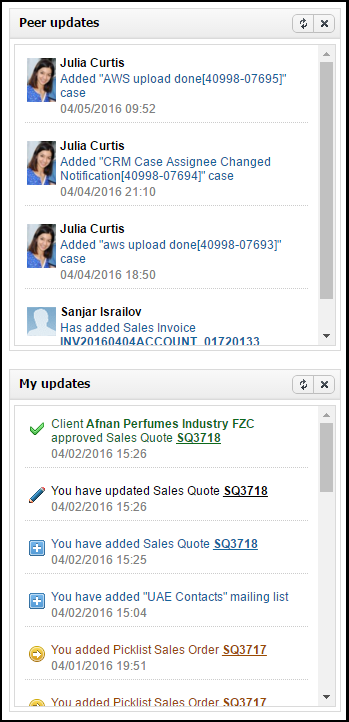
- Note List View "Download as PDF" Button fixed.
Meeting Minutes
- "Project name" and "Next Meeting" date fields added;
Now you can mention what project your meeting is related to and add the next meeeting date.
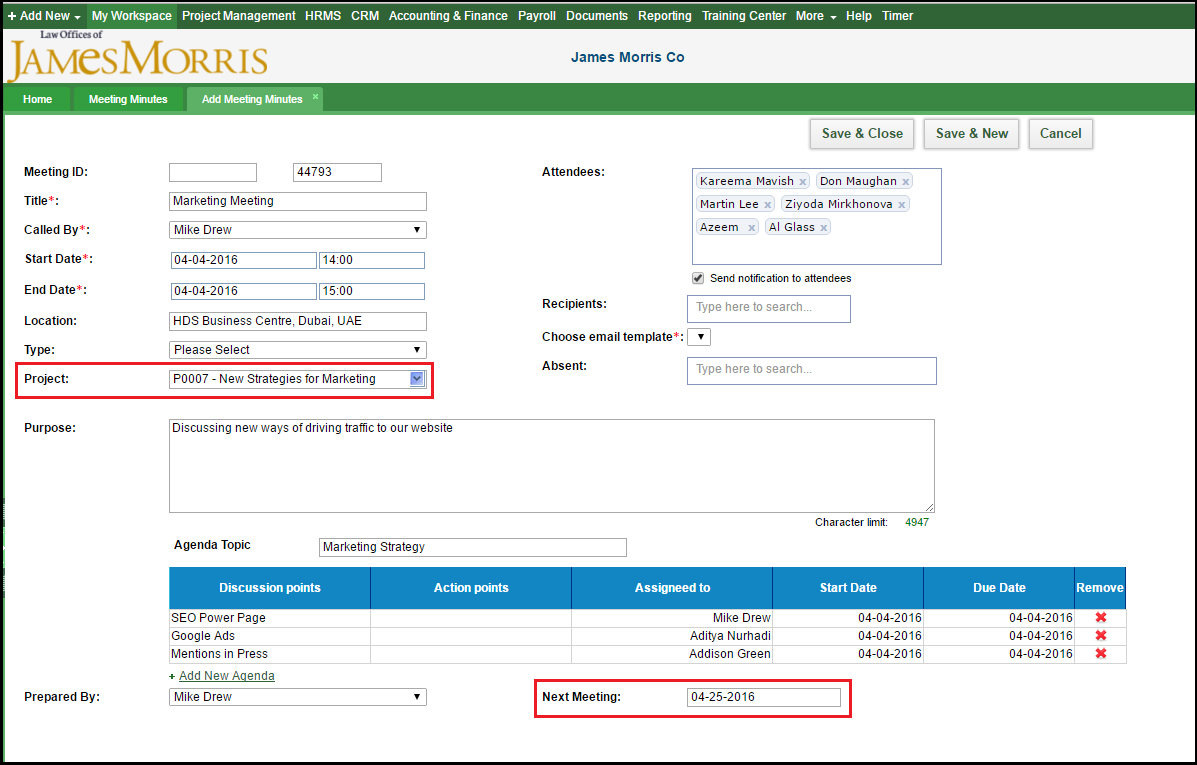
- Option to Add Custom Fields added;
To add a new custom field to Meeting Minutes you need to go to Settings -> Custom Field Management Settings -> HRMS Custom Fields -> New Custom Field.
Relates to: select “Meeting Minutes” from the dropdown;
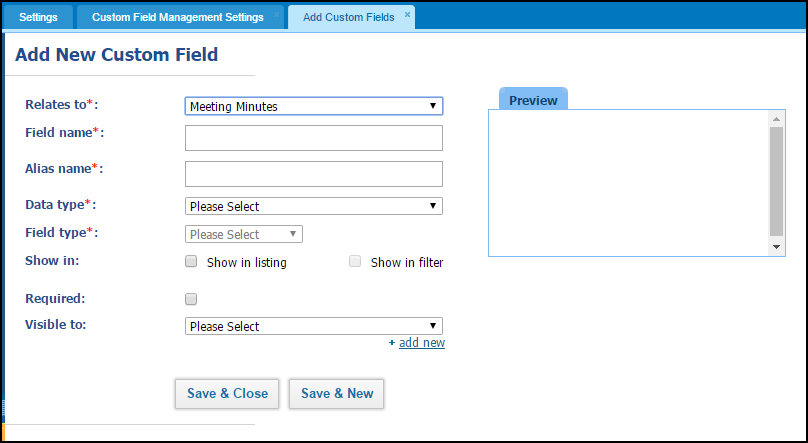 After saving new custom field will be available in the Meeting Minutes tab.
After saving new custom field will be available in the Meeting Minutes tab.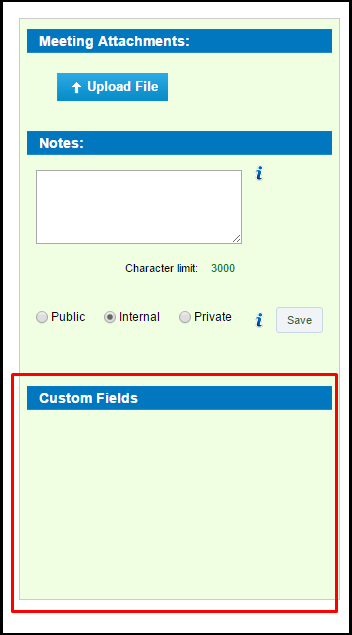 Project Management
Project Management
- Contracts list - option to export to PDF/Excel added;
- Column name changed from Comments to Notes in the Contract List View;
- Resource Utilization - dropdowns changed to lookup. Now it is easier to find department/employee/project. Start typing and find what you need straight away.
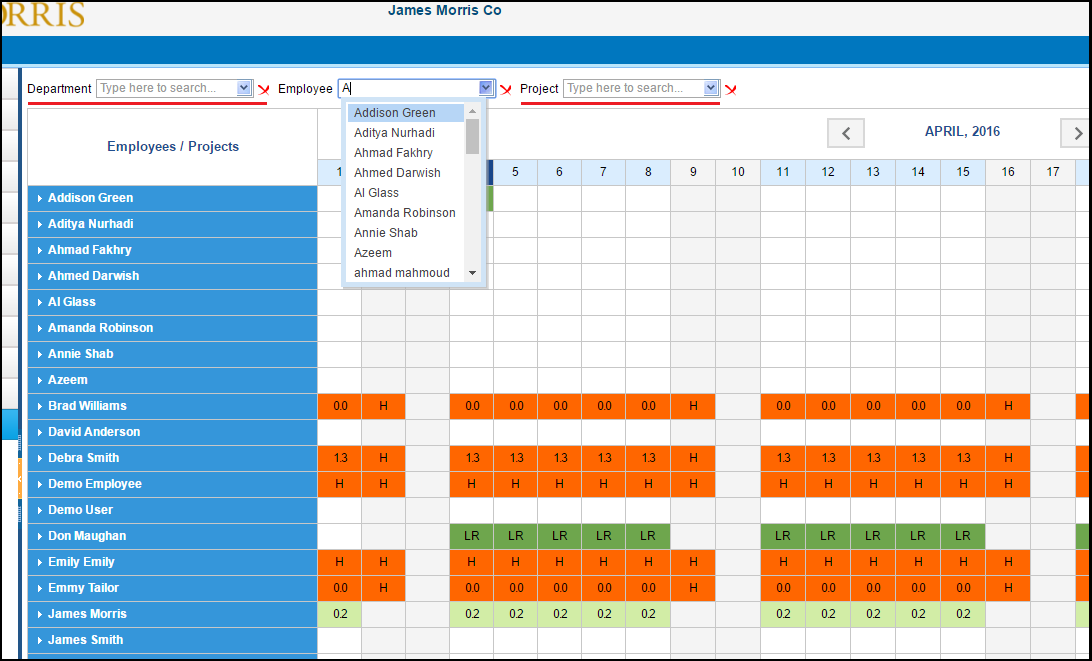
- Task document upload fix in Documents menu.
CRM
- Convert lead address to account feature added. Company data of the lead will be converted to a CRM account;
- Office 365 email integration copy from vCard contacts import/export option added. You can export your vCard contact list, if integrated with Office 365;
- Transfer related contact when converting opportunity to project - contacts that are related to the opportunity will transfer to the project, when converted;
- Added Sales Invoice, Sales Quotes and Sales Orders activity can bee viewed in Latest Activities.
Accounting
New features and options added.
- Added multi currency selling price option;
- Invoice payments now can be merged and splitted;
- Convert Sales Quote/Sales Order to Sales Invoice, Purchase Order to Purchase Invoice now is made with fixed exchange rate;
- Progressive Invoicing is made with fixed exchange rate;
- Sales order listing - "Net Total" column added;
- "Export to Excel" feature added for products with multi selling prices;
- Added "Generate Receipt" option on Credit Note Summary View;
- Adjusted discount number in more subdivisions (18.00% to be 18.0124%). Here, added option to change number format: default 0.00 can be changed to 0.0000 or 0.000, etc.;
- Stock Adjustment & Transfer Forms - Edit Option added;
- Add Bank Account Code to Bank Name in Receive Payment option added;
- Inventory list - Import button added, you can import from a CSV file;

- Accounting Homepage dashboard - Year to date - select a period to view the graph.
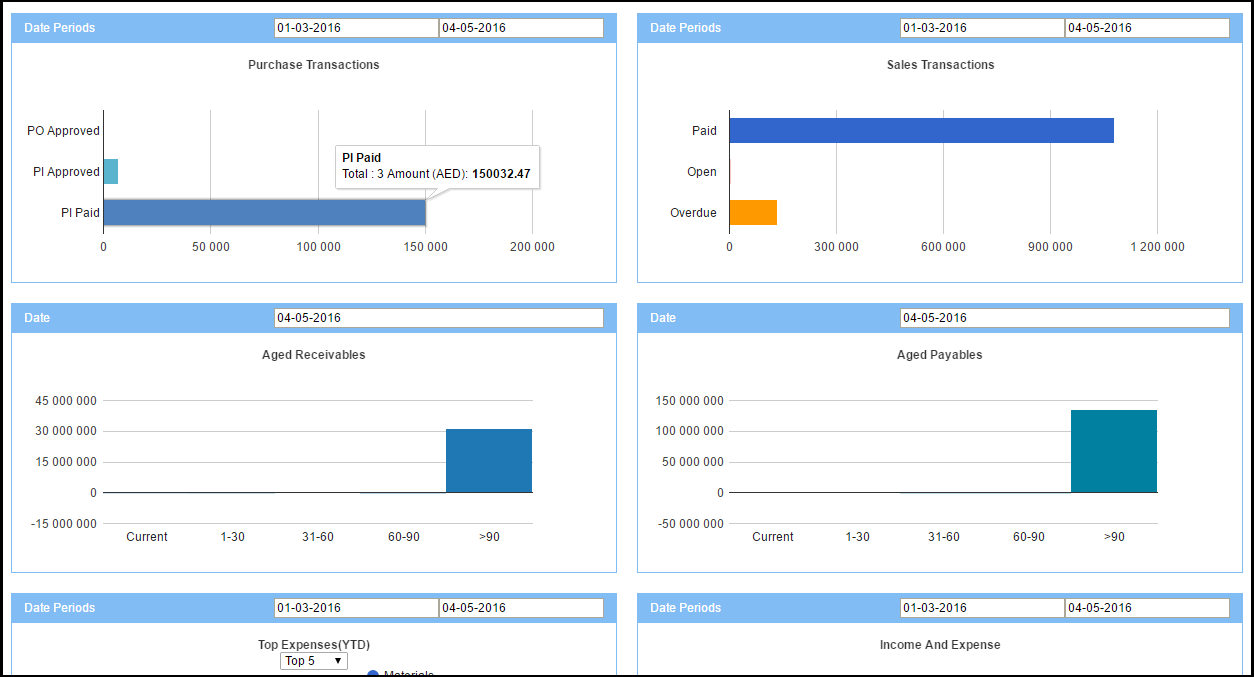
Payroll
- Leave encashment & leave deduction (implemented timeslot):
Leave encashment is an amount of money that an employee can request if he/she didn't take his/her vacation as a compensation.
Leave deduction if employee takes extra leaves, company will deduct the payment from salary for the extra leave days. Here, taken leave days are calculated and compared with employee time slot (working hours);
- Single Payrun PDF changes.
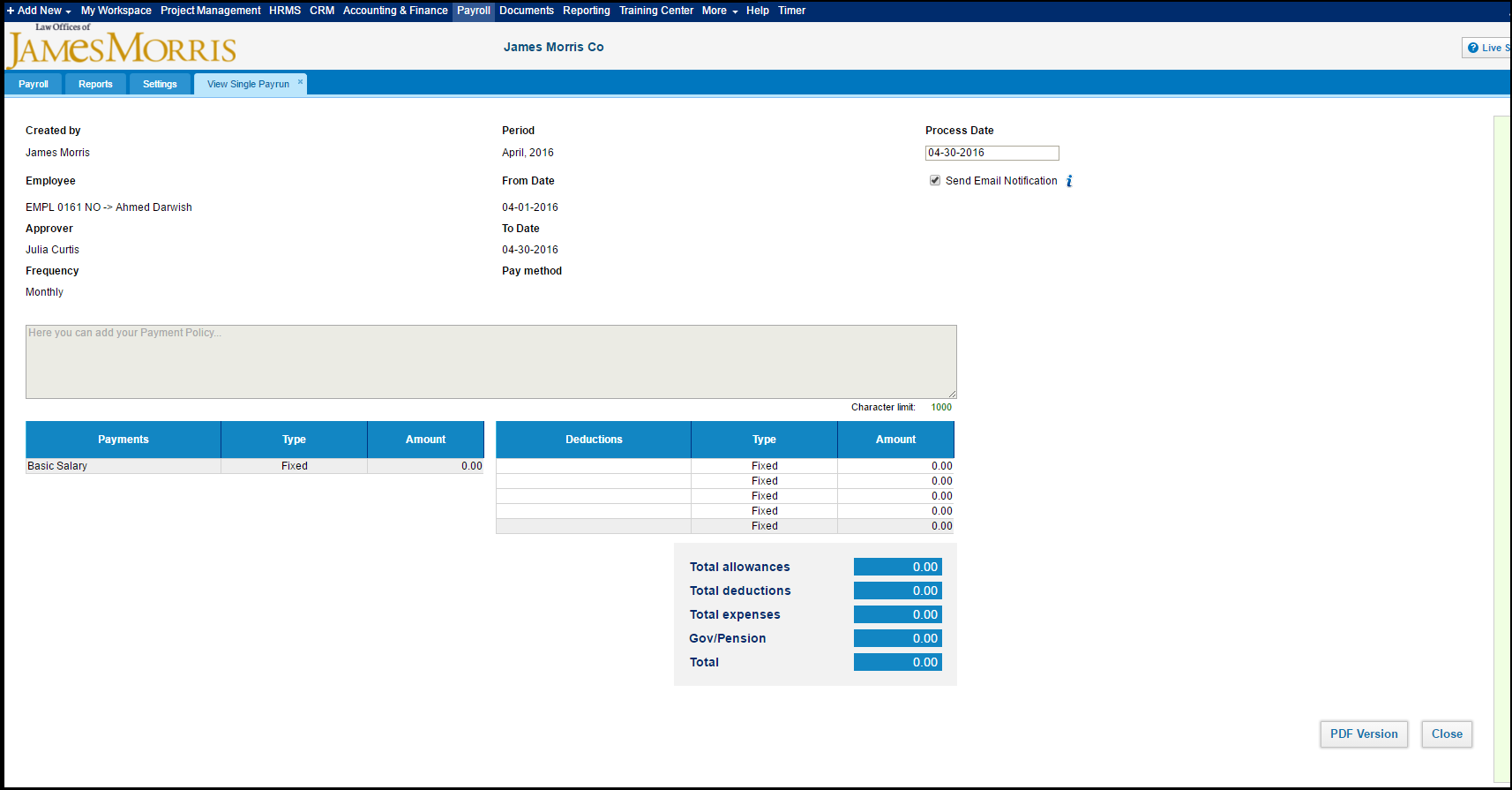
HRMS
- HR Dashboard PDF export option added;

- Holiday widget turn on/off option;
- Certificates list - added Filter by type;
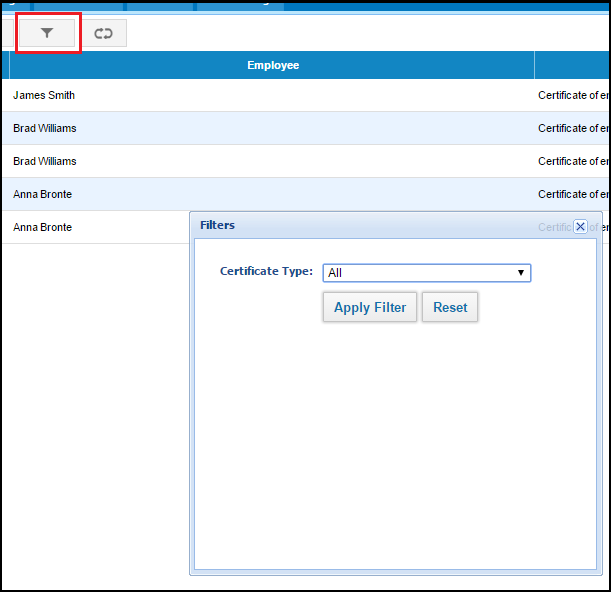
- Certificate list - employee code, search by employee code option added;
- Employee Incidents list has been added, you can add incidents by clicking on the "Add Incident" button.
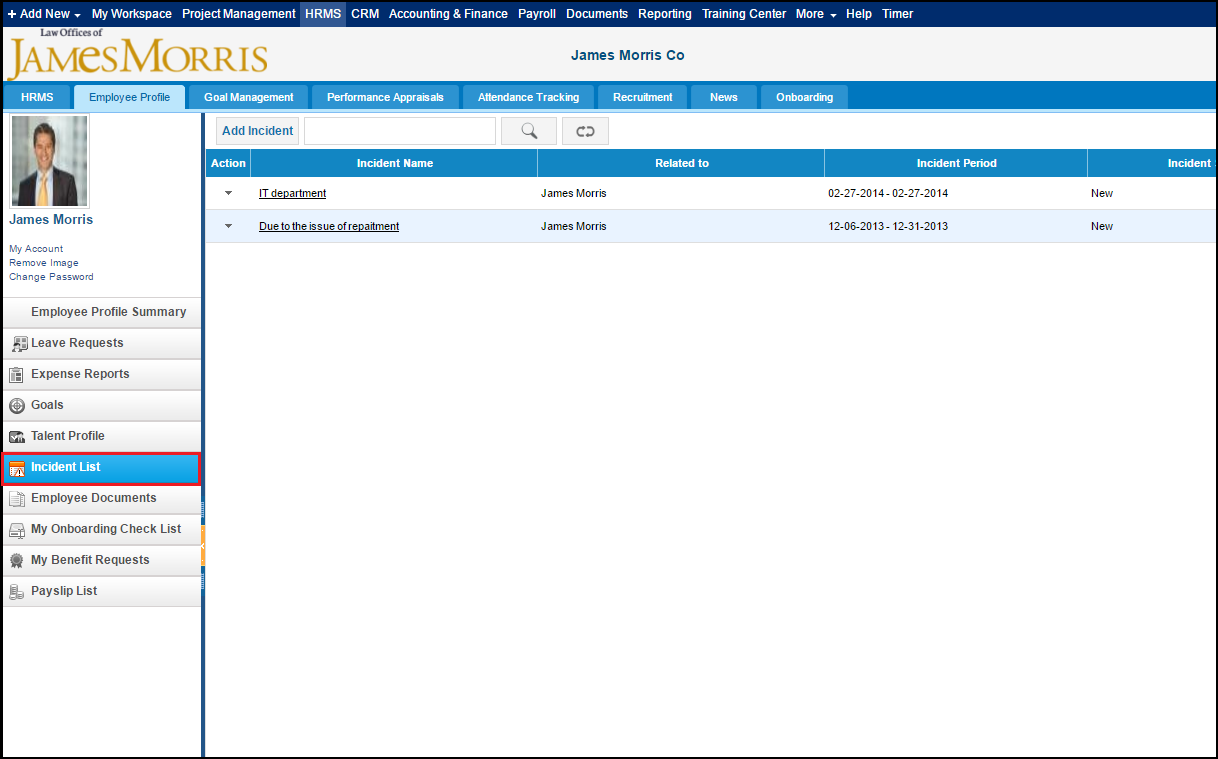
- Organizational chart has been added as a home menu;
- Candidate - option to add Expense claims agains candidate;
- Onboarding step can be integratied with Candidate;
- Added Employee/Candidate Code for Onboarding Steps;
- Email addresses with 7 symbols in domain name are allowed (for e.g. admin@be.network);
Fixes, interface changes and improvments:
- Widget Charts color scheme changed;
- HR widgets empty profile image style changes;
- Annual leave allowance columns show/hide issue fix;
- Vacancy list project filter issue fix;
- In/Out widget status font changed;
- Employee Documents search improvements;
Overall
- Recaptcha Upgrade on sign up form;

- Recurring's issue with editing & deleting fixed;
- Overall system optimization changes.
If you have questions related to the upgrades, please contact our customer support team.
E-mail: support@kpi.com
Skype: kpi.com
Phone:
(UK) +44 (0) 207 096 1245
(UAE) +971 4 424 3033
(US) +1 646 844 33 30
Three Reasons Why You Should Care About Data On-boarding
Published Date : March 3, 2016
What is Data On-Boarding
Data on boarding is transferring all your offline data about customers to digital world -either to your CRM system or to your marketing databases.Although data on boarding is not a new topic, most of the concepts and its applications to a real life is not yet understood well by most of the marketing experts and entrepreneurs.
Finding out customers offline purchases and matching them with online marketing campaigns made sense to the first eCommerce platforms. When a customer just bought something from you, it doesn't make sense to make an online ads that target the same product which they bought the next day. The smart marketers use offline data to learn about habits of retail customers and create smarter marketing segments.
However, data on-boarding has also become very essential for companies who do not deal with retail and physical selling too. Data on boarding is essential in both CRM and marketing activities of your own company. Although it may seem that data on boarding is complex and involves a lot of technology, it is not the case. Most of the customer data is already stored online. And for offline databases such as call centers there are already ready-made solutions available in the market.
If your customers use a mobile device, you can analyze what kind of websites they visited before encountering an article in your website. Mobile applications are able to identify a key associated with the hardware. Your online behavior can also be identified by your ip address and geo location. On boarding systems match your offline(mobile and web) activities with the associated customer and then remove a customer's identity for privacy concerns. You can then be able to analyze users behavior before landing to your website.
Last year, Google has launched Google’s custom audiences solution which allows advertisers to upload email lists of the leads and customers to google and to target them with specific ads. This was a huge move towards making data on boarding topic number one importance again. Before google, Facebook already had a solution available to attract custom audiences through Facebook advertising platform.
There are other solutions available in the market, like LiveRamp which you can use to segment your audiences. You can upload customers information like email and physical address to a platform, then, the system matches the identifier information with information in mobile devices, with its own offline databases and then the identifier information is removed for privacy. You can then use the data for intelligent segments and targeting your audience.
There are several types of data which you can onboard: offline data about the customer and online data about your prospects and leads.
What kind of data is worth being onboarded for small businesses?
Event Transactions - if the customer has made a purchase from you, most probably it is recorded in another system, or offline. If you recorded it from different system, you should ask vendors to export it for you.
Phone Conversations - if you are not recording phone conversations with customers, you should. If you do not have technical resources to record every call you have with a customer, you should take a note of customer service calls and record it in your crm system.
In person demos and presentations - personal demos are powerful, because they make you to understand the customer, their questions and their concerns while you are presenting them your product physically.
Three Reasons Why Smart Marketers Should Care About Data Onboarding
Offline data is bigger than you think
If you are in retail business, 90% of all transactions go offline.
If you are in consulting service business, all your interactions with customers including phone calls and meetings happen offline
All important trade-shows and conferences happen offline. Thankfully, nowadays, most conference attendees are scanned, swiped, badged, and ID’d before the entry.
If you want to create a buyer personas for your marketing campaigns, there is no way to analyze the behavior of the customer without seeing the offline data. When offline data is on-boarded, you can see the broader picture about the behaviors of your buyers.
You need to analyze the source of the conversion
If you have ads both in online and offline medium, you will have to analyze which medium was effective before making the most marketing decisions.
Smarter marketers analyze the data from different segments including offline and online.
Switch product goals with customer goals
Smarter marketers analyze the users behaviors that is covered beneath the surface. Knowing what kind of business goal or a personal goal your potential customer is trying to achieve before encountering your solution is a huge asset for marketers. Offline data helps to create need based segments from users point of view.
Slack is a good example of a company which tries to achieve users goals with a software. When users just signup for a free trial, instead of providing some training and demo videos, it asks what functional and personal goals users are trying to achieve with a software. Users learn to use slack at the same time answering questions about their goals and expectations.
4 Things SME Owners Should Consider
Published Date : February 19, 2016
Running a business in such economic volatile period is tough. You have to keep many things on mind and do activities which will be give ultimate results. Here are 4 points which I am sure will benefit you. Here we go:
Once Andrea Bocelli said on importance of intentions: “All that counts in life is intention”. I am sure it implies with any belief people choose. Number second book in authenticity in Islamic world after Quran is “Sahih Al-Bukhari” and it starts with hadith on purifying intentions. If your business is simply exporting clothes, put aims like “To create high quality products in reasonable prices to all”; “To create many working places to the people”, “To serve people in their need for clothing”. Spiritual motivation keeps you working till the end.
- Set Your Clear Business Goals
They should include and be SMART: Specific, Measurable, Action, Realistic, and Timeline. Let’s say If your intent to provide Accounting software you should ask yourself why my future customers should use my product? Who they are? Why they should stop using their current software if they have any? What would be your products advantages? Would it be more user-friendly? Cost effective? Will you more care about customers’ specific needs? Settings specific goals will help you to structure your core business model and find your niche in the ruthless business world.
Running a small business is completely different from what it used to be 10 years back. According to statistics dated by 2013 93% of marketers used social media for business, 70% marketers used Facebook to successfully gain new customers according to Search Engine Journal. A friend of mine found more than enough leads for his training business in less than 3 days just for less than 100 USD in Facebook. People are using social networks not just for connecting but also to find good products and services and good votes and testimonials give new insight and growth to your business. Social media boosts your business and encourages you to do better. Well, on this point I think no one said better then popular author Erik Qualman: “We do not have a choice on whether we DO social media but the question is HOW WELL WE DO IT”.
There many SaaS software available online today. SME Owners should focus cost effective and all inclusive ones. Where CRM should help to track their sales and marketing activities, they should also have to easily do orders, quotations and invoices through Accounting features. All in one SaaS software helps to reduce IT costs, paper headache, and multiple software jungle.
Abror Khasanov
Director of Sales in Kpi.com
Most Comprehensive KPIs in Sales and CRM
Published Date : February 17, 2016
KPIs in Sales matter not less than in any other field of business activity. Measuring and analyzing the right Key Performance Indicators is very important if you want to succeed, because they indicate how a business or team is performing against its goals. With this information you can make decisions and plan further actions. If you haven’t read the previous articles on KPIs, let me provide a definition, given by one of the famous best-selling business author, Bernard Marr.
“In simple terms a KPI is a way of measuring how well we as individuals or how well entire companies or business units are performing. KPI is short for Key Performance Indicator. A KPI should help us understand how well a company, business unit or individual is performing compared to their strategic goals and objectives.”
In this article we are going to observe what KPIs are considerable and need to be measured in the Sales Department, what KPIs in Sales you need to measure and analyze. To reveal what KPIs in Sales matter most, first of all, let’s define that sales department is the division of a business that is responsible for selling products or services. In some small companies there is only a sales team, not a whole department.
 Lead Flow.
This KPI essentially needs to be measured by all sales departments as it shows the quantity of people that are interested in the productservice. This indicator needs to be measured each month/quarter/half-year/year. Another criteria is where these leads came from. For example, how many of them came from social media, or by referral, newspaper or other channels. This way you can analyze and decide what channel is providing you more leads and focus on it.
Extra: If you need the detailed analysis of leads, you can also track how many leads converted to customers and which channel brings more customers. It is obvious that more leads = more customers, but if you want to emphasize on the leads tracking, you will definitely need this information. This will be another KPI in sales, it is called Lead-to-Customer Conversion Rate. It is measured in percents. Calculation is simple: the number of new customers divided by the number of qualified leads. This way you will know the rate at which your leads become customers and analyze what actions you need to perform improve your lead-to-sale conversion rate.
What is a qualified lead? A qualified lead is more than just contact details. It includes further information on the person or the company they represent, information that qualifies them for a certain product.
Lead Flow.
This KPI essentially needs to be measured by all sales departments as it shows the quantity of people that are interested in the productservice. This indicator needs to be measured each month/quarter/half-year/year. Another criteria is where these leads came from. For example, how many of them came from social media, or by referral, newspaper or other channels. This way you can analyze and decide what channel is providing you more leads and focus on it.
Extra: If you need the detailed analysis of leads, you can also track how many leads converted to customers and which channel brings more customers. It is obvious that more leads = more customers, but if you want to emphasize on the leads tracking, you will definitely need this information. This will be another KPI in sales, it is called Lead-to-Customer Conversion Rate. It is measured in percents. Calculation is simple: the number of new customers divided by the number of qualified leads. This way you will know the rate at which your leads become customers and analyze what actions you need to perform improve your lead-to-sale conversion rate.
What is a qualified lead? A qualified lead is more than just contact details. It includes further information on the person or the company they represent, information that qualifies them for a certain product.
 Customer/Sales Flow.
Similar to Leads Flow this KPI shows how many customers the firm has gained during the current month/quarter/half-year/year. It helps you evaluate company’s success, as one of the biggest goals of every firm is maximizing income which can be achieved by increasing the number of customers/sales.
Customer/Sales Flow.
Similar to Leads Flow this KPI shows how many customers the firm has gained during the current month/quarter/half-year/year. It helps you evaluate company’s success, as one of the biggest goals of every firm is maximizing income which can be achieved by increasing the number of customers/sales.
 Cost per lead
Also called CPL. Every action you commit in order to attract new leads has its cost. It can be, for example, the cost of the landing page web design, social media advertisement or TV commercial. You can calculate the cost per lead performance indicator by summing up all your monthly (or any other period needed) marketing and advertising expenses and divide them by the number of monthly new leads. Don’t forget to include the salary of your marketing workers (according to the appropriate period of work). The lower is the indicator - the better is your current situation.
Extra: Again, if you need more detailed information, you will need to measure another key performance indicator - Cost Per Conversion. Just as CPL it indicates everything you spend to convert lead to sale. It will be much higher than the previous KPI.
Calculation: Sum of all your monthly marketing costs divided by the number of monthly new customers or sales.
Here, you can measure the Average Conversion Time KPI, in addition. How much time it took for a lead to become a customer.
Customer turnover rate
Customer turnover rate stands for how many of your customers refused to use your product/service. Also called as churn rate. Company should analyze the reasons why customers quit using their services. Was it because of the high price, bad customer service or a greater deal from your competitor.
Calculation: Number of customers that left / Total number of customers * 100%
Cost per lead
Also called CPL. Every action you commit in order to attract new leads has its cost. It can be, for example, the cost of the landing page web design, social media advertisement or TV commercial. You can calculate the cost per lead performance indicator by summing up all your monthly (or any other period needed) marketing and advertising expenses and divide them by the number of monthly new leads. Don’t forget to include the salary of your marketing workers (according to the appropriate period of work). The lower is the indicator - the better is your current situation.
Extra: Again, if you need more detailed information, you will need to measure another key performance indicator - Cost Per Conversion. Just as CPL it indicates everything you spend to convert lead to sale. It will be much higher than the previous KPI.
Calculation: Sum of all your monthly marketing costs divided by the number of monthly new customers or sales.
Here, you can measure the Average Conversion Time KPI, in addition. How much time it took for a lead to become a customer.
Customer turnover rate
Customer turnover rate stands for how many of your customers refused to use your product/service. Also called as churn rate. Company should analyze the reasons why customers quit using their services. Was it because of the high price, bad customer service or a greater deal from your competitor.
Calculation: Number of customers that left / Total number of customers * 100%
 Sales volume
Sales performed can be measured by a specific period of time, for example: year. half-year. quarter, month, week, day. This is the most informative key performance indicator for the sales department. Analyzing this indicator we can reveal answers to important questions as “How to improve sales results” or “How to increase sales”. By looking through the growth/recession of sales during the specific period of time we can find out what actions, made by us led to the growth or downturn of the sales volume.
In conclution, here are some interesting and motivational statistics that may help sales managers:
Sales volume
Sales performed can be measured by a specific period of time, for example: year. half-year. quarter, month, week, day. This is the most informative key performance indicator for the sales department. Analyzing this indicator we can reveal answers to important questions as “How to improve sales results” or “How to increase sales”. By looking through the growth/recession of sales during the specific period of time we can find out what actions, made by us led to the growth or downturn of the sales volume.
In conclution, here are some interesting and motivational statistics that may help sales managers:
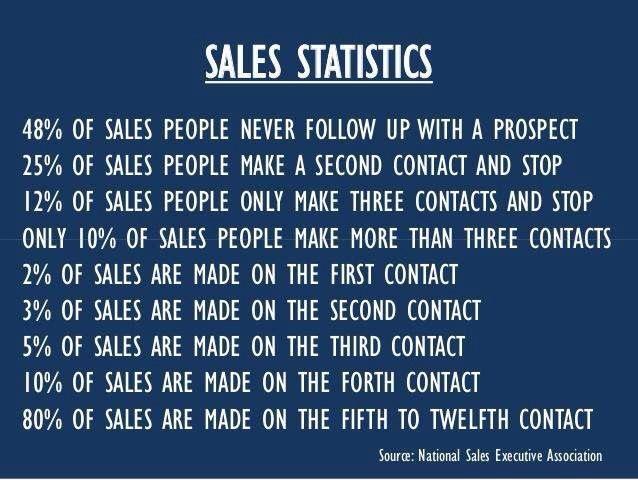 Think about that, good luck in your business!
Image credentials: http://www.hoopla.biz/#!motivation-station/c1g4s
https://www.nasp.com/
Think about that, good luck in your business!
Image credentials: http://www.hoopla.biz/#!motivation-station/c1g4s
https://www.nasp.com/
February 2016 System Upgrades
Published Date : February 16, 2016
Dear kpi.com users,
We are glad to announce that kpi.com has launched its monthly upgrades for February 2016. Improvements are made in the Project Management, CRM, Accounting, HRMS, Payroll modules and the system’s overall performance. We put all our effort to improve existing features of the system and add new features according to our client’s feedback and requests. Thank you gratefully for your patience, understanding and goodwill, we do our best to add new features and resolve the appeared issues as soon as possible for your comfort and convenience.
Workspace
Meeting Minutes tool. Now you can send email notifications to Guests, set up email templates
Project Management
Contracts - added document attachments option. Now you can upload your documents and import them from Google to add them as attachments to your contracts.
Contract list - added Notes and Start/End columns showing the contract start and end date.
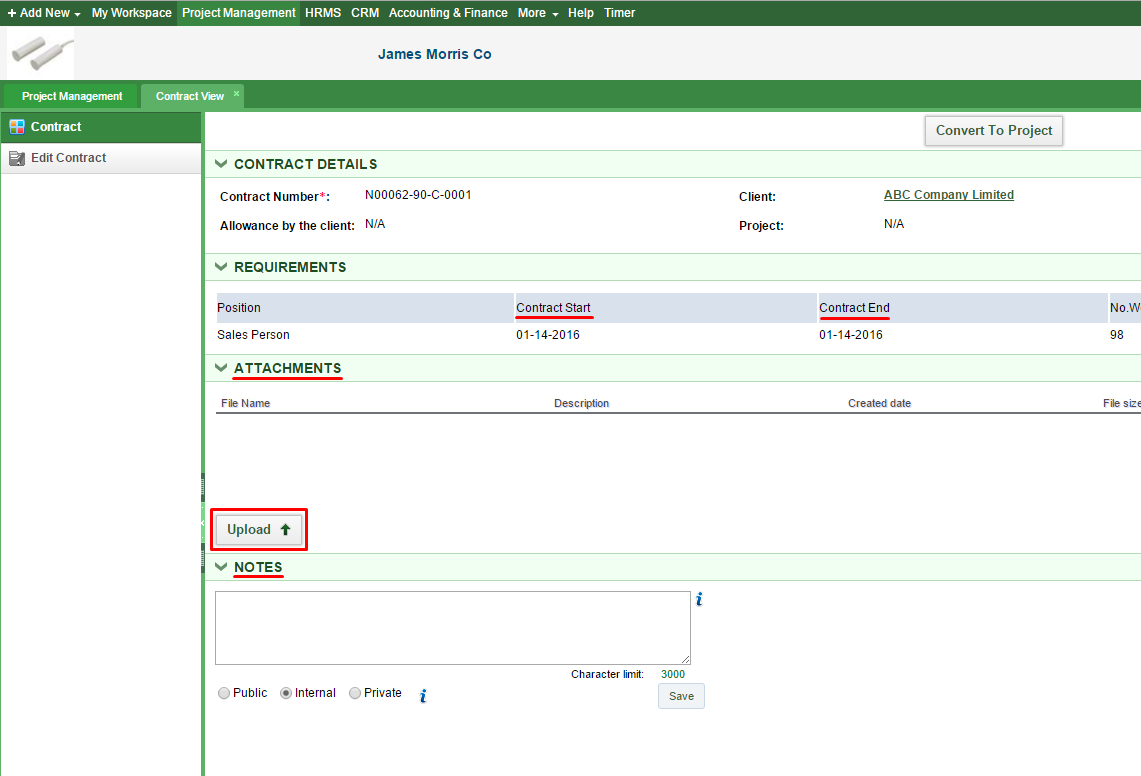 CRM
Import contact from CSV is optimized for speed and performance.
CRM
Import contact from CSV is optimized for speed and performance.
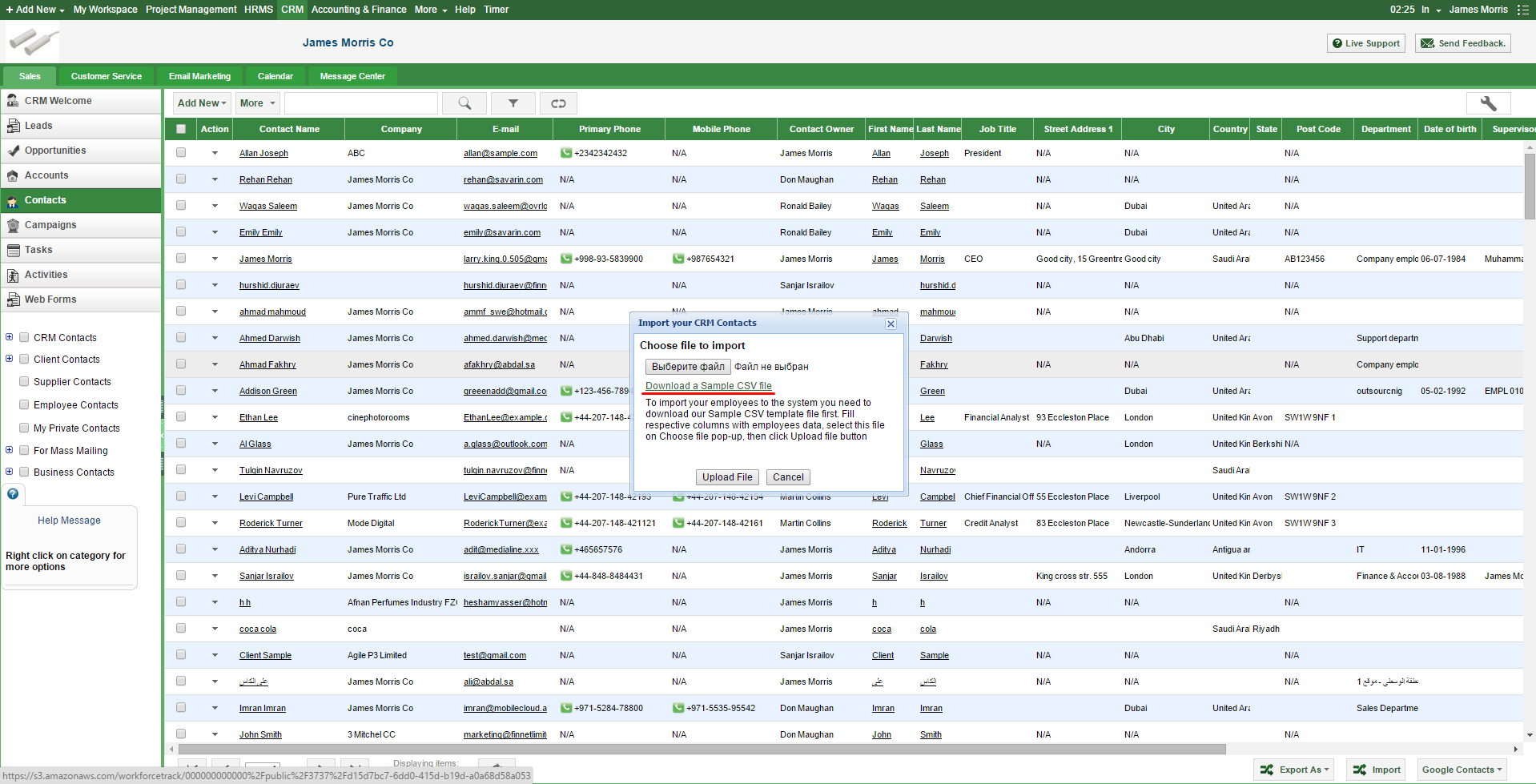 Accounting
Purchase order receive type field has been added. Now you can receive purchase order by quantity and by amount.
Once you click on Receive button total quantity of the purchased item will be added to Receive field. In the Receive field you can change the quantity of received items that allow you receive partial amounts, or even more than ordered.
Accounting
Purchase order receive type field has been added. Now you can receive purchase order by quantity and by amount.
Once you click on Receive button total quantity of the purchased item will be added to Receive field. In the Receive field you can change the quantity of received items that allow you receive partial amounts, or even more than ordered.
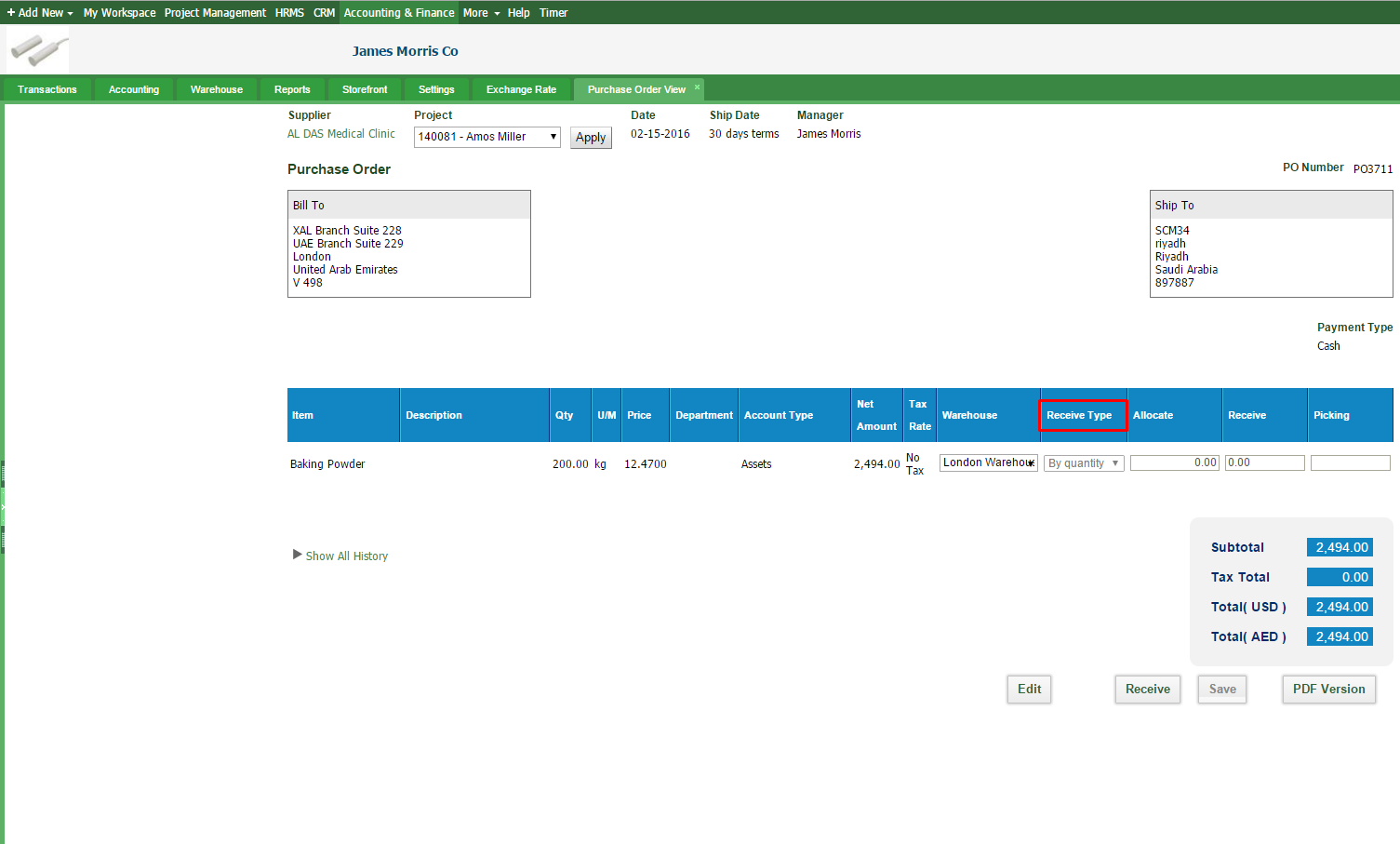 Added discounts into add/edit product form - shows discounts list from Accounting settings, wich makes it easier to access the discounts page and set up discounts.
Added discounts into add/edit product form - shows discounts list from Accounting settings, wich makes it easier to access the discounts page and set up discounts.
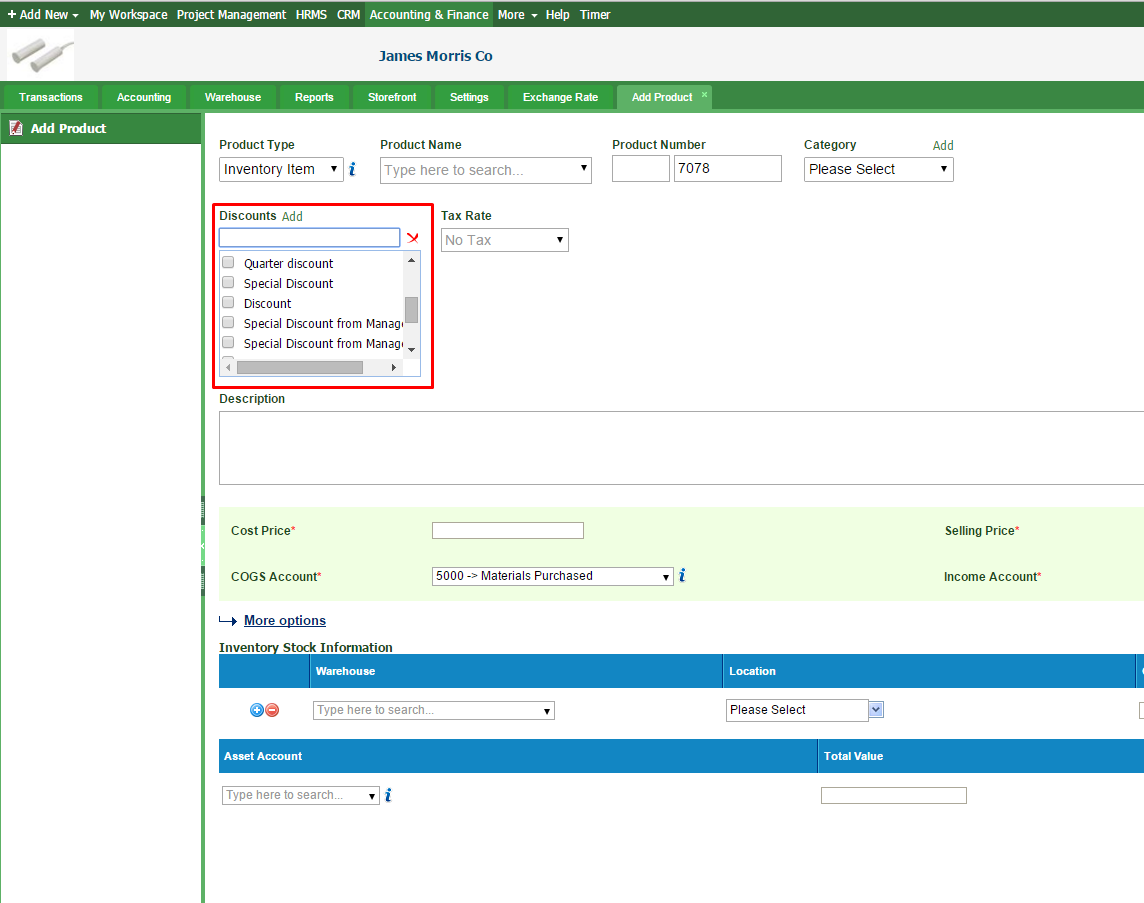 Added new Currency Widget
Added multi currency option into Balance Sheet report, now you can choose a currency from the dropdown menu.
Added new Currency Widget
Added multi currency option into Balance Sheet report, now you can choose a currency from the dropdown menu.
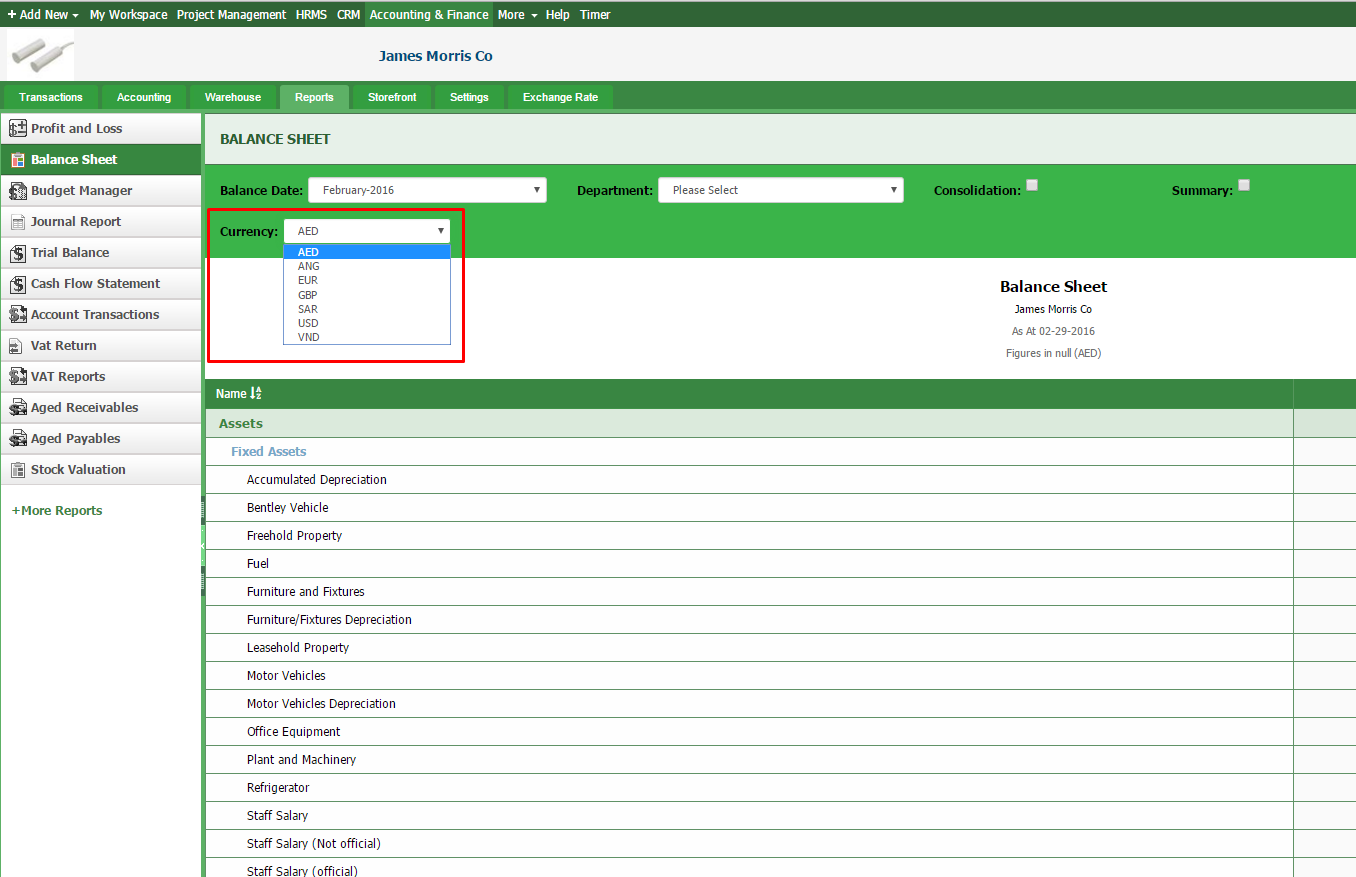 Payroll
Manage sending notification to employees
HRMS
Employee list - option to quickly change or add phone numbers. Double tap on the phone number to edit it. Click on the check mark to save.
Payroll
Manage sending notification to employees
HRMS
Employee list - option to quickly change or add phone numbers. Double tap on the phone number to edit it. Click on the check mark to save.
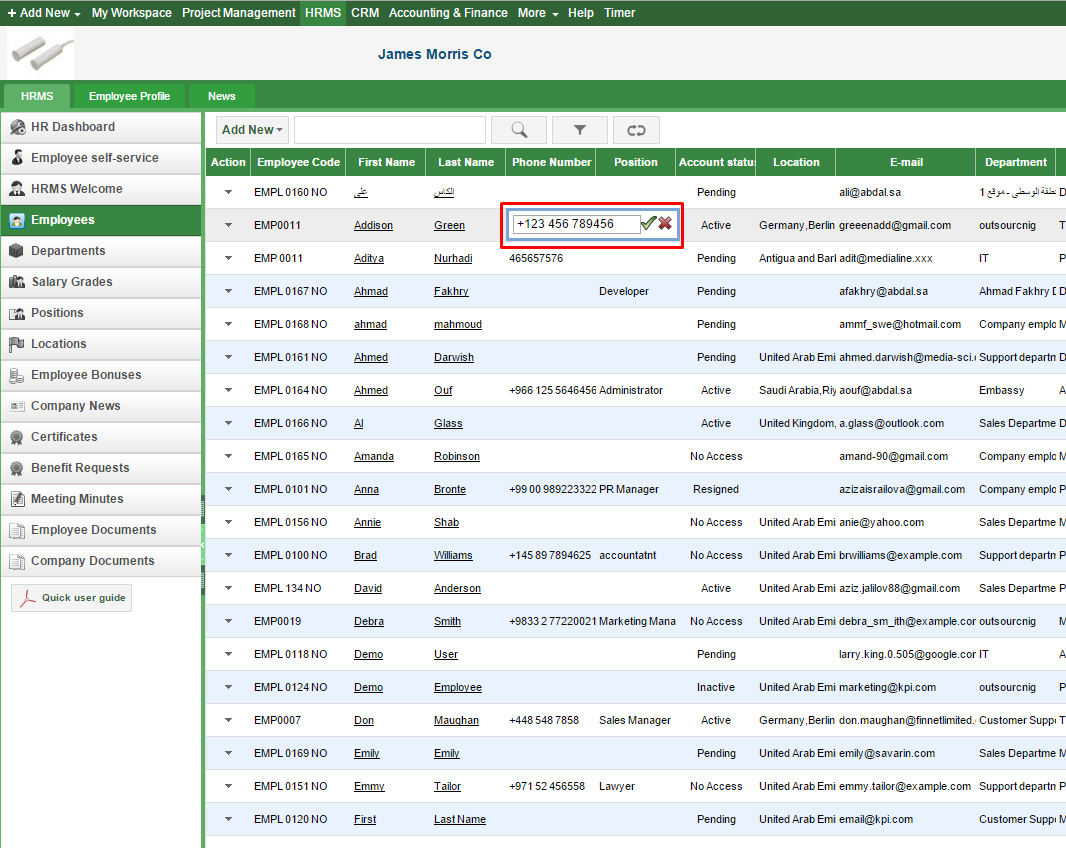 Employee leave allowance - option to select previous years added.
Certificates - option to attach employee image docs to certificates added.
New certificate templates added:
Employee leave allowance - option to select previous years added.
Certificates - option to attach employee image docs to certificates added.
New certificate templates added:
- Employment certificate
- No objection certificate
- Job offer letter
- Salary certificate
- Salary transfer letter
- Contract termination letter
- Employee warning letter
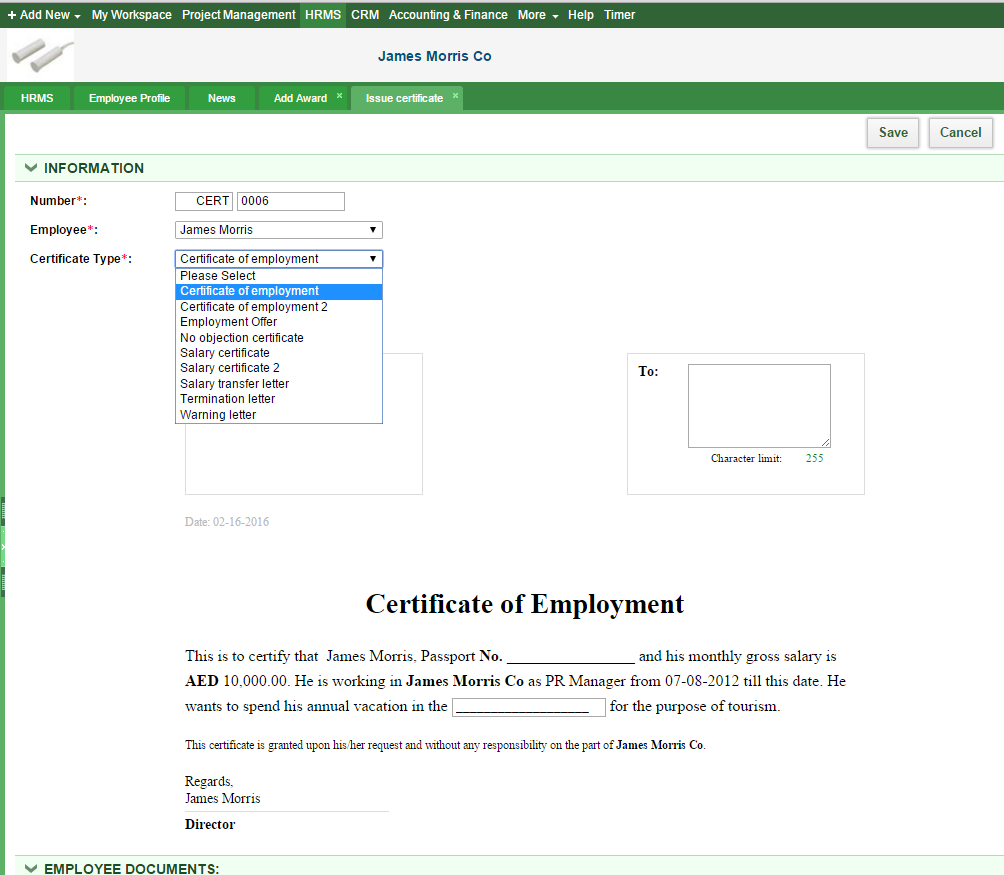 Existing position names can't be saved to avoid duplication.
Attendance report - PDF export option added.
Customize Recruitment Countries and Embassies option added.
Vacancy form - country, embassy, gender, contract type etc. fields added
If you have questions related to the upgrades, please contact our customer support team.
E-mail: support@kpi.com
Skype: kpi.com
Phone: (UK) +44 (0) 207 096 1245
(UAE) +971 4 424 3033
(US) +1 646 844 33 30
Existing position names can't be saved to avoid duplication.
Attendance report - PDF export option added.
Customize Recruitment Countries and Embassies option added.
Vacancy form - country, embassy, gender, contract type etc. fields added
If you have questions related to the upgrades, please contact our customer support team.
E-mail: support@kpi.com
Skype: kpi.com
Phone: (UK) +44 (0) 207 096 1245
(UAE) +971 4 424 3033
(US) +1 646 844 33 30
Our Unique Experience of Operating as a Cross-Cultural Diverse Team
Published Date : February 4, 2016
There are a lot of whitepapers and scholarly articles about managing diverse multi culture teams in multinational and multicultural cities. Managing diverse teams has its own benefits and advantages, as well as challenges. Having culturally diverse employees is more fun in software development companies like ours.
In this post, we will share how we manage multi-cultural teams. Although we are considered a relatively small software development company, we have employees who operate from different parts of the world. Namely, there are our employees who work for us in US, Canada, Uzbekistan, UK and UAE. Our main operational office is located in Tashkent, Uzbekistan. All strategic decisions are made in Dubai office in UAE and London office, UK. Our Dubai office has employees from different cultures and backgrounds. Even in our main operational office in Tashkent, you can see people from different backgrounds and from different parts of the country, some of them speak only in one language, which is not the official language in the country.
It is generally considered that cross-cultural and cross national collaborations often fail. Especially when you operate in different time-zones, with different legislation and different understandings of what is good and what is bad. We agree that it is tough to operate business from all parts of the globe. And here is what we do to manage cultural differences:
Making hiring processes transparent and formalized
By this we mean that when hiring people we are looking for some of the essential skills that employees should possess. Those skills include ability to work in teams, ability to work with others from different backgrounds and ability to manage conflicts. We formalized our hiring process so that we hire not only a good person with good skills but also a person who can communicate well and work with others as a team.
By creating a clear specific employee on-boarding scheme
After hiring process is finished, we make sure that employees pass some on-boarding time. Different teams have different on boarding activities. When an employee is hired to a new team, the team leader of that team is responsible for introducing the employee to everyone and making sure that they have everything that they need. The team leader is also responsible for introducing some ground rules of the company, including the dress code, filling out time-sheets and some other ground rules.
On-boarding new employees is essential when you need to deal with hiring a lot. But on culturally diverse teams, on-boarding makes even more sense and it becomes even more essential.

By making the communication more transparent
In our company, we try hard in order to create a friendly working environment for everyone.
However, communication problems and misunderstandings are sometimes unavoidable. When communicating a real message from our customers we try to use simple words. When making presentations to several group of people we prefer to use images to explain our point more clearly.
By making teams more agile and autonomous
Autonomy is a real power to motivate teams with diverse people. We killed 2-3 level approval processes and before doing something, manager should approve it behavior. Instead, we made teams more goal-oriented and independent. When teams are goal oriented, they forget about cultural differences and try to work together to achieve that goal.
By making teams agile we enforced frequent learning culture and iterative/incremental development to achieve our goals. We make sure to try different stuff together until we find out what works for us.

Conclusions
Theses are just the small tips we can offer to diverse companies. We are by no means perfect. We have our own struggles and issues in our company related to people and the company strategy. However, by implementing those small changes, we were able to greatly reduce some conflicts and work better.
Some Examples of Great Customer Service Reps from Tech Companies
Published Date : February 4, 2016
We were excited to read about Len's laundry experience at groovehq.com. Leaving the everlasting first impression is essential for all companies, but when it comes to tech companies, we have an impression that customer service reps can't do a lot. We tend to think that the software/technology should be great, it's all about the interface, tech, delivery, everything, not about reps.
So I decided to search for some amazing customer service reps in It/Tech industry. Customer service reps can do a lot, and here is how. These companies have hired some great people to deal with customers and we should learn from them.
- Amazon always had a great customer service, this time is not an exception:

2. Great customer service example from AT&T
 3. Buffer is also a great company that values customers. Buffer's cofounder Leo Widrich responded with a real help to a user's critique.
3. Buffer is also a great company that values customers. Buffer's cofounder Leo Widrich responded with a real help to a user's critique.
 4. Dreamhost even goes beyond offering totally free accounts for non-profit companies. The company treats all issues/requests from non-profit companies as paid ones.
5. My favorite one is Rackspace. It is a company which has hired really great people for serving customers. During a troubleshooting call, the customer said that he was very hungry. The rep from Rackspace ordered him a free pizza during the call.
4. Dreamhost even goes beyond offering totally free accounts for non-profit companies. The company treats all issues/requests from non-profit companies as paid ones.
5. My favorite one is Rackspace. It is a company which has hired really great people for serving customers. During a troubleshooting call, the customer said that he was very hungry. The rep from Rackspace ordered him a free pizza during the call.

Key Performance Indicators: Intro [Infographic]
Published Date : February 3, 2016
Key Performance Indicators: Definition, Types, Search Criteria, Visualization
“Measurement is the first step that leads to
control and eventually to improvement.
If you can’t measure something, you can’t understand it.
If you can’t understand it, you can’t control it.
If you can’t control it, you can’t improve it.”
― H. James Harrington
A Key Performance Indicator (KPI) is a measurable value that demonstrates how effectively a company is achieving key business objectives. Companies use KPIs to evaluate their success at reaching their goals.
Key Performance Indicators can be measured in different fields of your business from sales, marketing to financial and accounting departments. Each department has certain indicators that need to be measured and analyzed.
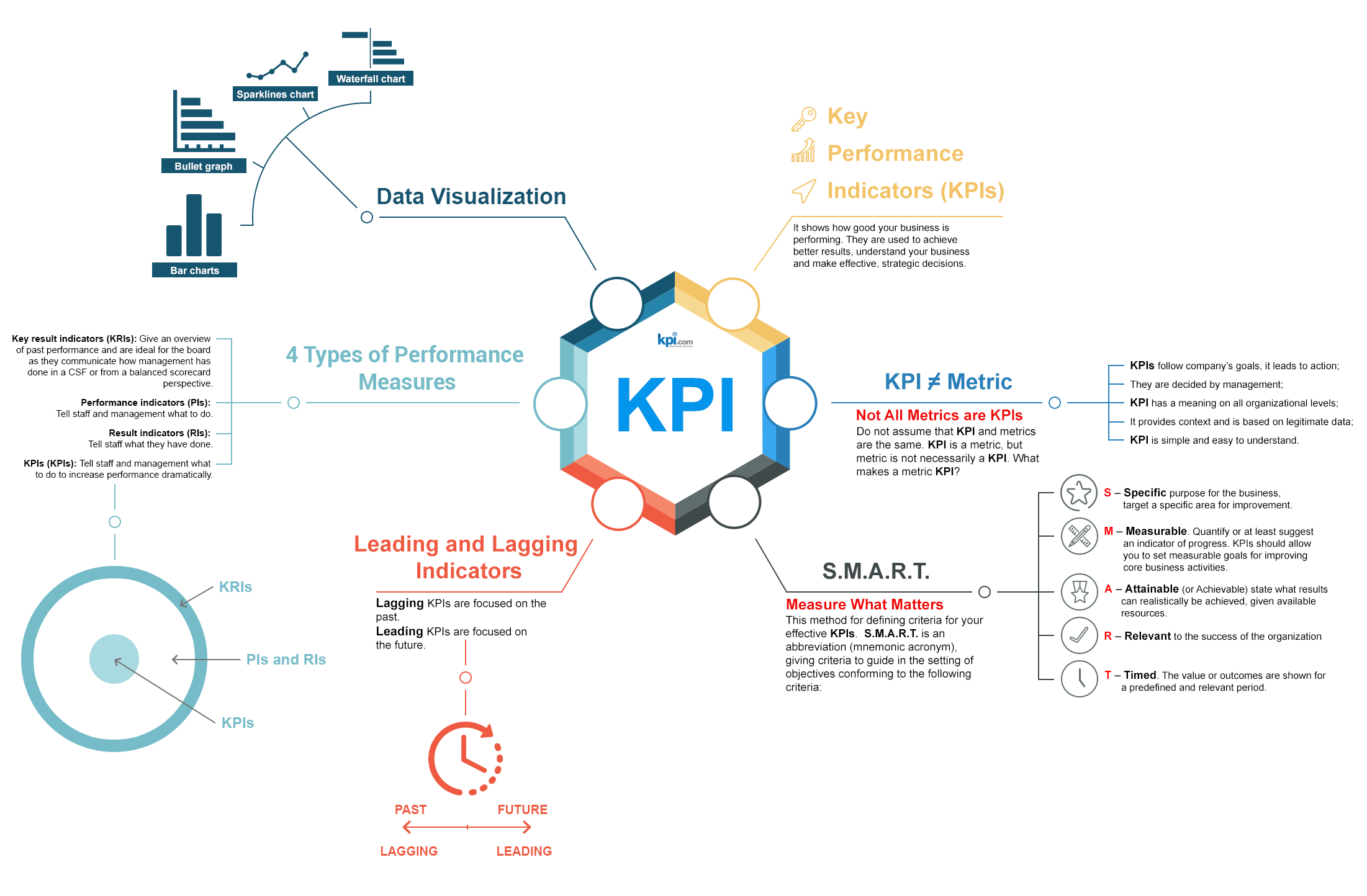 Every area of business has specific metrics that should be monitored, measured and analyzed – marketers track campaign statistics, sales teams monitor new opportunities and leads, and HR managers control the turnover rate.
Not all metrics are necessary Key Performance Indicators. And not all KPIs need to be measured and significant for the company. Various determination methods help us to define what Key Performance Indicators we need to take into account in our specific area of activity.
Every area of business has specific metrics that should be monitored, measured and analyzed – marketers track campaign statistics, sales teams monitor new opportunities and leads, and HR managers control the turnover rate.
Not all metrics are necessary Key Performance Indicators. And not all KPIs need to be measured and significant for the company. Various determination methods help us to define what Key Performance Indicators we need to take into account in our specific area of activity.
S.M.A.R.T. Key Performance Indicators criteria
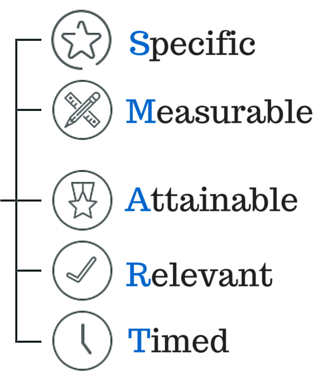 To evaluate the relevance of a KPI is to use the SMART method. The letters in the acronym stand for specific, measurable, attainable, relevant, timed. In other words, they should answer the following questions:
To evaluate the relevance of a KPI is to use the SMART method. The letters in the acronym stand for specific, measurable, attainable, relevant, timed. In other words, they should answer the following questions:
- Is your objective Specific, is it specified?
- Can you Measure the progress towards that goal?
- Is the goal real, is it Attainable?
- Is the goal Relevant to your organization?
- What is the Time limit for achieving this goal?
KPIs can be divided into Lagging and Leading.
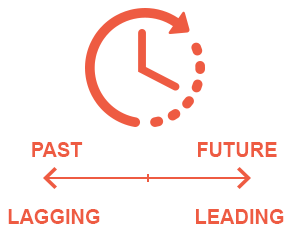 Lagging KPIs are focused on the past. They measure the output. For example, in HR the “Turnover rate” is a lagging KPI. Lagging KPIs tell us story about the current state of your HR, but they don’t tell you how to change this state. While leading KPIs are focused on the future. Leading KPIs measure the input that should be introduced to achieve better results. KPIs are important for analysis and monitoring: they tell you different stories about your objectives.
Different types of performance measure: KRIs, PIs, RIs, KPIs.
The relationship between these four performance measures can be compared to the structure of an onion - multilayered. The outside layer describes the overall condition of the objective. The inner layers show the performance and result indicators, and the core is where the Key Performance Indicators are.
Lagging KPIs are focused on the past. They measure the output. For example, in HR the “Turnover rate” is a lagging KPI. Lagging KPIs tell us story about the current state of your HR, but they don’t tell you how to change this state. While leading KPIs are focused on the future. Leading KPIs measure the input that should be introduced to achieve better results. KPIs are important for analysis and monitoring: they tell you different stories about your objectives.
Different types of performance measure: KRIs, PIs, RIs, KPIs.
The relationship between these four performance measures can be compared to the structure of an onion - multilayered. The outside layer describes the overall condition of the objective. The inner layers show the performance and result indicators, and the core is where the Key Performance Indicators are.
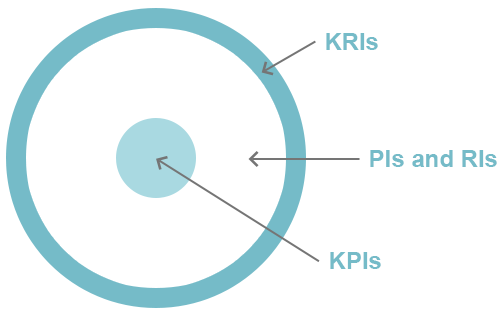 When we have the Key Performance Indicators measured, the data itself can be difficult to percept and analyze. This is the reason we need to use data visualization which makes the process simple and understandable, increasing efficiency of the received data by focusing on important items, revealing trends, tendencies and allowing to trace over time changes.
Waterfall Chart. A waterfall chart is a form of data visualization that helps in understanding the cumulative effect of sequentially introduced positive or negative values. The waterfall chart is also known as a flying bricks chart or Mario chart due to the apparent suspension of columns (bricks) in mid-air.
When we have the Key Performance Indicators measured, the data itself can be difficult to percept and analyze. This is the reason we need to use data visualization which makes the process simple and understandable, increasing efficiency of the received data by focusing on important items, revealing trends, tendencies and allowing to trace over time changes.
Waterfall Chart. A waterfall chart is a form of data visualization that helps in understanding the cumulative effect of sequentially introduced positive or negative values. The waterfall chart is also known as a flying bricks chart or Mario chart due to the apparent suspension of columns (bricks) in mid-air.
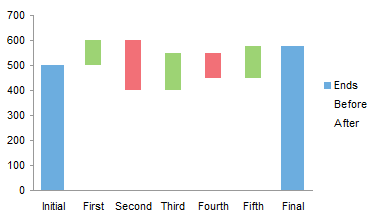 Sparkline Chart. A sparkline is a very small line chart, typically drawn without axes or coordinates. It presents the general shape of the variation (typically over time) in some measurement. Sparklines are small enough to be embedded in text, or several sparklines may be grouped together as elements of a small multiple.
Sparkline Chart. A sparkline is a very small line chart, typically drawn without axes or coordinates. It presents the general shape of the variation (typically over time) in some measurement. Sparklines are small enough to be embedded in text, or several sparklines may be grouped together as elements of a small multiple.
 Bar Chart or Bar Graph is a chart that presents grouped data with rectangular bars with lengths proportional to the values that they represent. The bars can be plotted vertically or horizontally.
Bar Chart or Bar Graph is a chart that presents grouped data with rectangular bars with lengths proportional to the values that they represent. The bars can be plotted vertically or horizontally.

 Bullet Graph. A bullet graph is a variation of a bar graph.It serves as a replacement for dashboard gauges and meters. Bullet graphs were developed to overcome the fundamental issues of gauges and meters: they typically display too little information, require too much space, and are cluttered with useless and distracting decoration.
Bullet Graph. A bullet graph is a variation of a bar graph.It serves as a replacement for dashboard gauges and meters. Bullet graphs were developed to overcome the fundamental issues of gauges and meters: they typically display too little information, require too much space, and are cluttered with useless and distracting decoration.
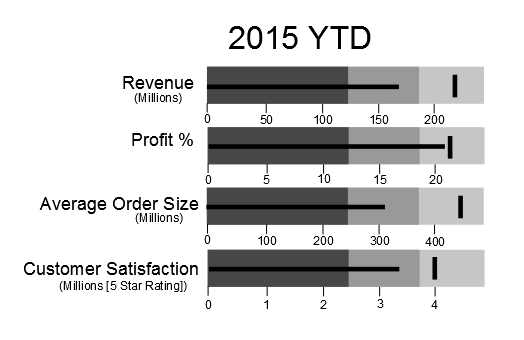 Also, Pie Chart. A pie chart (or a circle chart) is a circular statistical graphic, which is divided into slices to illustrate numerical proportion. In a pie chart, the arc length of each slice (and consequently its central angle and area), is proportional to the quantity it represents.
Also, Pie Chart. A pie chart (or a circle chart) is a circular statistical graphic, which is divided into slices to illustrate numerical proportion. In a pie chart, the arc length of each slice (and consequently its central angle and area), is proportional to the quantity it represents.
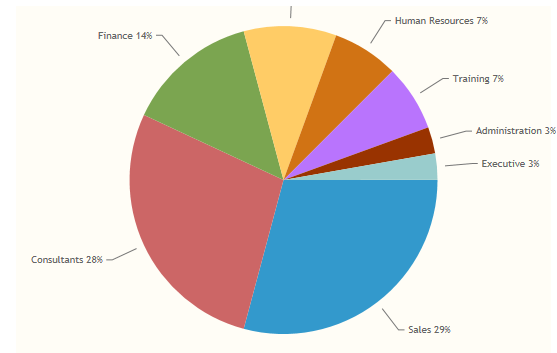 Tips for KPI Data Visualization
Tips for KPI Data Visualization
- Avoid too many data points in a singular chart;
- Use effective color schemes;
- Avoid attempting to compare too many indicators in one chart;
- Don’t use dark backgrounds;
- Avoid overcrowding;
- Try to keep them simple, without 3D effects.
Embed This Image On Your Site (copy code below):
Definitive Guide to KPIs in Project Management. Part
Published Date : February 2, 2016
In the previous post we discussed the meaning of Project Management, traditional approach to it, factors that affect it, Key Performance Indicators in general and listed essential KPIs of Project Management and in this article we are going to continue the list.
What KPIs in Project Management can and must be measured using the KPIs we have listed in the former article, such as AC, BAC, EAC and PV.
 Percentage of Completed Planned – This KPI describes the percentage of work which was planned to be completed by the Reporting Date.
Calculation:
% Completed Planned = PV / BAC (Budget at Completion)
Percentage of Completed Actual – The percentage of work which was actually completed by the Reporting Date.
Calculation:
% Completed Actual = AC / EAC (Estimate at completion)
Deviation of planned budget (%) This KPI shows the variation of the planned budget (or cost) is the difference in total costs between the planned and actual budget.
Calculation:
Actual budget/ Planned Baseline x 100
Deviation of planned hours of work (%) – Just like the first KPI in this article, this is the deviation of the planned work is the difference in work hours between the planned baseline as compared against the actual statement of work.
Calculation:
Actual hours spent / Planned hours of work x 100%
Deviation of planned time schedule for project/program – The deviation of the planned time schedule is the difference in time between the planned baseline against the actual schedule.
Percentage of milestones missed – This KPI helps managers keep track of the percentage of projects that have missed milestones. Percentage of milestones as recorded in all projects/programs that have been missed. Identifying milestones and achieving goals are important to maintaining project. When too many milestones are not achieved or are shifted, employees may feel frustrated. Identifying when milestones are missed can help restart a project and mitigate similar challenges in the future.
Percentage of overdue project tasks – Percentage of the tasks that are not finished yet.
Calculation:
Quantity of the overdue tasks / Total quantity of tasks x 100%
Cost of managing processes – Costs of managing processes in a special period of time, usually based on the number of Full Time Equivalent personnel (FTEs) involved in management functions or processes.
Calculation:
Total cost for managing processes / Period of time
Performance Index (CPI) – Earned Value divided by the actual cost (BCWP/ACWP).
Cost Schedule Index (CSI) – Cost Performance Index times Schedule Performance Index (CPI x SPI). CSI measures the likelihood of recovery for project that is late and/or over budget
Cost Variance (CV) Earned Value minus the actual cost (BCWP-ACWP).
Estimate at Completion (EAC) – The actual cost of work performed (ACWP) plus the estimate to complete (ETC) for all of the remaining work.
Schedule Performance Index (SPI) – Earned Value divided by the planned value (BCWP/BCWS).
Schedule Variance (SV) – Earned Value minus the planned budget for the completed work (BCWP-BCWS).
Percentage of Completed Planned – This KPI describes the percentage of work which was planned to be completed by the Reporting Date.
Calculation:
% Completed Planned = PV / BAC (Budget at Completion)
Percentage of Completed Actual – The percentage of work which was actually completed by the Reporting Date.
Calculation:
% Completed Actual = AC / EAC (Estimate at completion)
Deviation of planned budget (%) This KPI shows the variation of the planned budget (or cost) is the difference in total costs between the planned and actual budget.
Calculation:
Actual budget/ Planned Baseline x 100
Deviation of planned hours of work (%) – Just like the first KPI in this article, this is the deviation of the planned work is the difference in work hours between the planned baseline as compared against the actual statement of work.
Calculation:
Actual hours spent / Planned hours of work x 100%
Deviation of planned time schedule for project/program – The deviation of the planned time schedule is the difference in time between the planned baseline against the actual schedule.
Percentage of milestones missed – This KPI helps managers keep track of the percentage of projects that have missed milestones. Percentage of milestones as recorded in all projects/programs that have been missed. Identifying milestones and achieving goals are important to maintaining project. When too many milestones are not achieved or are shifted, employees may feel frustrated. Identifying when milestones are missed can help restart a project and mitigate similar challenges in the future.
Percentage of overdue project tasks – Percentage of the tasks that are not finished yet.
Calculation:
Quantity of the overdue tasks / Total quantity of tasks x 100%
Cost of managing processes – Costs of managing processes in a special period of time, usually based on the number of Full Time Equivalent personnel (FTEs) involved in management functions or processes.
Calculation:
Total cost for managing processes / Period of time
Performance Index (CPI) – Earned Value divided by the actual cost (BCWP/ACWP).
Cost Schedule Index (CSI) – Cost Performance Index times Schedule Performance Index (CPI x SPI). CSI measures the likelihood of recovery for project that is late and/or over budget
Cost Variance (CV) Earned Value minus the actual cost (BCWP-ACWP).
Estimate at Completion (EAC) – The actual cost of work performed (ACWP) plus the estimate to complete (ETC) for all of the remaining work.
Schedule Performance Index (SPI) – Earned Value divided by the planned value (BCWP/BCWS).
Schedule Variance (SV) – Earned Value minus the planned budget for the completed work (BCWP-BCWS).
 Deciding what KPIs in Project Management you need to measure and analyze, don’t forget that effective KPIs should be S.M.A.R.T. (Specific, Measurable, Attainable, Realistic, Time-based) and:
Deciding what KPIs in Project Management you need to measure and analyze, don’t forget that effective KPIs should be S.M.A.R.T. (Specific, Measurable, Attainable, Realistic, Time-based) and:
- Agreed upon by all parties before the project begins
- Quantifiable measurements can be shared, analyzed and discussed across your team at any time
- Regularly measured
- Directed toward the benefits the project seeks to deliver
- Aligned with objectives and project goals
- Cost-effective
- Reflective of an organization’s success factors
KPIs in Project Management are used not only as a performance management tool, but also as a motivational tool. When all teams are united with common goals, their individual contributions can shine. Team competition, incentives and rewards can be a powerful motivating tool to keep project pushing forward. Using attainable and consistent KPIs can help project managers assess project goals in an objective, fair and powerful way.
Definitive Guide to KPIs in Project Management. Part
Published Date : February 2, 2016
If you want your project to succeed, you need to know what is a Key Performance Indicatior and what KPIs in Project Management you need to know and measure.
To have a clear notion on what is project management is and what are the duties of a PM manager, we need to be aware of what is “to manage” as a verb:
To manage:
- succeed in doing something
- deal successfully
- organize and control
- be able to provide something
- be available for something
So, project managers need to deal, to able to provide, organize and control everything related to the project in order to lead it to success.
Project management is discipline of initiating, planning, executing, controlling, and closing the work of a team to achieve specific goals and meet specific success criteria. It is all about achieving goals by completing projects that contribute to their objectives. When you set up a new project, you need to pay attention to lots of different factors, such as benefits, risks, budget, and objectives.
A project manager should keep everything under control, there are a number of approaches for managing project activities, it depends on the type of the project and its peculiarity. However, traditional approach to project management is the standard for the project management of a project. The processes of project management should be carefully addressed by the project manager and performed by the project team. Here they are:
- Initiation stage – creating an idea for a project, determining whether or not it benefits the organization. During this stage, a decision making team will identify if the project can realistically be completed.
- Planning stage – drawing a project plan, writing, outlining the work that needs to be performed. During this stage, a team should prioritize the project, calculate a budget and schedule, and determine what resources are needed.
- Execution and construction stage – when the tasks are given and teams are informed of responsibilities. Here the work starts. This is a good time to bring up important project related information.
- Monitoring and controlling stage – project managers need to compare project status and progress to the actual plan, as resources perform the scheduled work. During this stage, project managers may need to adjust schedules or do what is necessary to keep the project on track.
- Completion and conclusion stage – after project tasks are completed and the client has approved the outcome, an evaluation is necessary to highlight project success and/or learn from project history.
It is important to know that not all projects will pass every stage, they even may not have all the stages, as projects can be terminated before they reach completion. Some projects do not follow a structured planning or monitoring process. And some projects will go through steps 2, 3 and 4 multiple times, different cases occur while process.
Key Performance Indicators (KPIs) in Project Management show how well teams are achieving specific goals, it consist of various specific measurement tools. As you see, project management is a huge, complex and unpredictable concept. That is why the KPIs can vary from one to another according to the going-on processes. Project management KPIs should be generally agreed upon early in the project. They reflect the organization’s central concept of the project and solidify project responsibility across administrative divisions.
A project manager can set the KPIs for each element and thereby track the status accordingly with an increased potential for overall success. Factors can affect Project Management are divided to internal and external:
Internal or in-project factors are: time, cost, scope, quality, risk, resources.
External or around-project factors include: sustainability, relevance, impact, politics.
Why Project Management needs KPIs?
Key Performance Indicators in Project management provide a window not only into the current status of the project or its past performance, but also serve as a means to detect future problems. Different KPIs can bring in different insights into the project as a whole, allowing for several views for the project manager and team.
KEY – a major element that leads to success or failure of the project;
PERFORMANCE – a metric that can be managed, measures, adjusted and controlled during the project lifecycle;
INDICATOR – a simple to understand and interpret on current and likely future base.
As it was said in the article about KPIs in HRMS, the same criteria works for KPIs in Project Management, you can use a S.M.A.R.T. way to analyze which KPIs you need for your project, there is a numerous quantity of them. We will be giving a few essential examples with a brief definition.
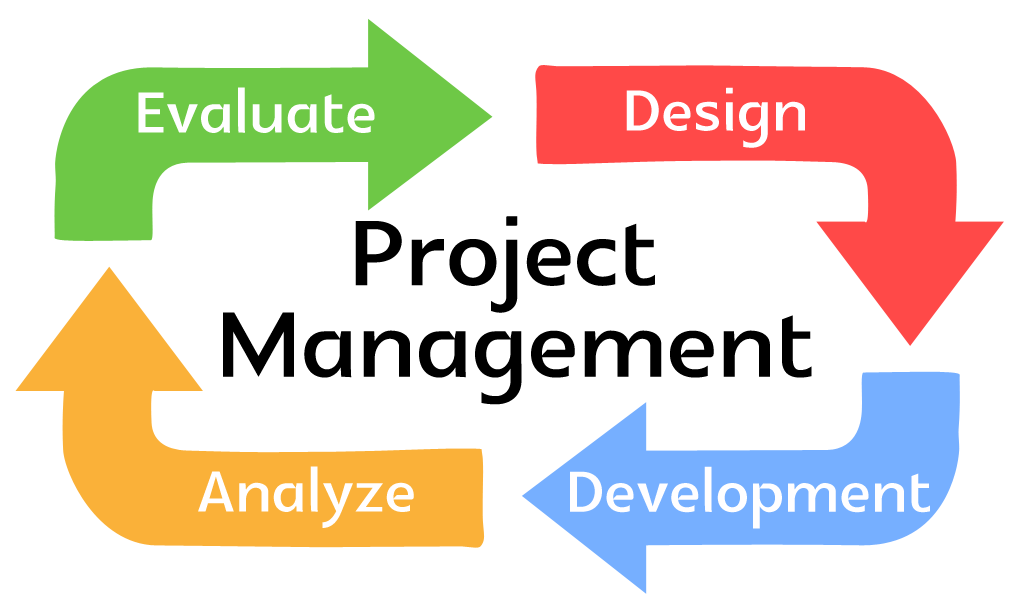 Actual Cost (AC). This KPI indicates how much money you have spent on a project as to date. To calculate it you need too sum up all the project-related expenses you’ve used to date. (Also called as Actual Cost of Work Performed (ACWP) – The sum of actual costs of activities that are completed).
Planned Value (PV). The planned value is the estimated cost for your project activities planned/scheduled as of reporting date.
Can be calculated by these formulas:
PV = (the hours left scheduled on the project) X (project worker’s hourly rate)
PV = (Planned % of tasks left to complete) X (project budget)
Project budget is calculated considering all the hours planned for the project, so use the time spent on tasks to calculate the Actual Cost spent on salaries, resources etc.
Also can be named as Budgeted Cost of Work Scheduled (BCWS) – The budgets of the activities that are planned or scheduled to be completed. It is a project management KPI that answers the question: how much cost should be spent on the project for the work that should be done up to a certain date according to your schedule.
Calculation:
BCWS = Total Budgeted Cost * Scheduled Project Percentage
Estimate at completion. Estimate at completion (EAC) shows the cost of the project as the project progresses.
How to calculate:
EAC = actual costs (AC) + budget at completion (BAC) – earned value (EV)
or
EAC = actual costs (AC) + estimate to complete (ETC)
Estimate to completion. Estimate to complete (ETC) is how much more money will need to be spent to complete the project.
ETC = estimate at completion (EAC) – actual costs (AC)
or
ETC = new estimates
Deviation of planned time schedule for project. The deviation of the planned time schedule is the difference in time between the planned baseline against the actual schedule.
How to measure:
Actual Schedule/ Planned Baseline x 100%
Deviation of planned budget. The deviation of the planned budget (cost) is the difference in costs between the planned baseline against the actual budget.
Resource utilization. Resource utilization measures how the time of team members is used while working on the project. It implies how much time are people working on billable activities compared to the time spent on non-billable tasks.
An excellent project dashboard gives a complete overview of the project and team performance. Depending on your goals, add to your KPI tracking dashboard accurate metrics that help you make informed decisions and to keep your hand on the pulse of all projects. Read the second part of the article KPIs in Project Management here.
Actual Cost (AC). This KPI indicates how much money you have spent on a project as to date. To calculate it you need too sum up all the project-related expenses you’ve used to date. (Also called as Actual Cost of Work Performed (ACWP) – The sum of actual costs of activities that are completed).
Planned Value (PV). The planned value is the estimated cost for your project activities planned/scheduled as of reporting date.
Can be calculated by these formulas:
PV = (the hours left scheduled on the project) X (project worker’s hourly rate)
PV = (Planned % of tasks left to complete) X (project budget)
Project budget is calculated considering all the hours planned for the project, so use the time spent on tasks to calculate the Actual Cost spent on salaries, resources etc.
Also can be named as Budgeted Cost of Work Scheduled (BCWS) – The budgets of the activities that are planned or scheduled to be completed. It is a project management KPI that answers the question: how much cost should be spent on the project for the work that should be done up to a certain date according to your schedule.
Calculation:
BCWS = Total Budgeted Cost * Scheduled Project Percentage
Estimate at completion. Estimate at completion (EAC) shows the cost of the project as the project progresses.
How to calculate:
EAC = actual costs (AC) + budget at completion (BAC) – earned value (EV)
or
EAC = actual costs (AC) + estimate to complete (ETC)
Estimate to completion. Estimate to complete (ETC) is how much more money will need to be spent to complete the project.
ETC = estimate at completion (EAC) – actual costs (AC)
or
ETC = new estimates
Deviation of planned time schedule for project. The deviation of the planned time schedule is the difference in time between the planned baseline against the actual schedule.
How to measure:
Actual Schedule/ Planned Baseline x 100%
Deviation of planned budget. The deviation of the planned budget (cost) is the difference in costs between the planned baseline against the actual budget.
Resource utilization. Resource utilization measures how the time of team members is used while working on the project. It implies how much time are people working on billable activities compared to the time spent on non-billable tasks.
An excellent project dashboard gives a complete overview of the project and team performance. Depending on your goals, add to your KPI tracking dashboard accurate metrics that help you make informed decisions and to keep your hand on the pulse of all projects. Read the second part of the article KPIs in Project Management here.
Ultimate Guide to Key Performance Indicators in HR
Published Date : January 20, 2016
Key Performance Indicators (KPIs) show how good your business is performing. To achieve better results, understand your business and make effective, strategic decisions you need to use KPIs.
KPIs can be measured in different fields of your business from sales, marketing to financial and accounting departments. Each department has certain indicators that need to be measured and analyzed.
Do not assume that KPI and metrics are the same. KPI is a metric, but metric is not necessarily a KPI. What makes a metric KPI?
- KPIs follow company’s goals, it leads to action;
- They are decided by management;
- KPI has a meaning on all organizational levels;
- It provides context and is based on legitimate data;
- KPI is simple and easy to understand.
 In this article we will be talking about key performance indicators in HR. Human resources department is responsible for everything that is connected with hiring, managing, firing, sourcing, searching, tracking, benefiting, interviewing staff, payroll etc. No matter what size your business is, human resources department is a significant component of the firm’s efficiency.
The goal of HR management is to help the company achieve its mission by hiring the right people, training and managing them to reach progress.
It turns out that HR KPIs are one of the most exponential for the company. What KPIs does it include? There are more than 100 metrics, so let us observe the primary indicators.
Employee turnover. Simply this indicators show the number (or %) of employees that leave the firm and are replaces by others. For example, usually positions that need high-skilled personnel have low turnover when unskilled positions have high turnover as these workers can be easily replaced by others. Turnover rate is the percentage of employees in a workforce that leave during a certain period of time. It includes:
In this article we will be talking about key performance indicators in HR. Human resources department is responsible for everything that is connected with hiring, managing, firing, sourcing, searching, tracking, benefiting, interviewing staff, payroll etc. No matter what size your business is, human resources department is a significant component of the firm’s efficiency.
The goal of HR management is to help the company achieve its mission by hiring the right people, training and managing them to reach progress.
It turns out that HR KPIs are one of the most exponential for the company. What KPIs does it include? There are more than 100 metrics, so let us observe the primary indicators.
Employee turnover. Simply this indicators show the number (or %) of employees that leave the firm and are replaces by others. For example, usually positions that need high-skilled personnel have low turnover when unskilled positions have high turnover as these workers can be easily replaced by others. Turnover rate is the percentage of employees in a workforce that leave during a certain period of time. It includes:
- Cost per hire;
- Turnover cost;
- Turnover rate;
- Time to fill;
- Female to male ratio.
Recruiting. This group of indicators help you understand where to source your best recruits, how well your new hires are performing and how did bad hires affect your financial state (training costs, HR costs and other). It involves:
- Vacant period;
- New hires;
- Performance appraisal;
- Turnover rate of new hires;
- Financial impact of bad hire.
 Retention. This group shows the ability of the firm to retain its employees. Preventable turnover means the loss of employees, reasons why they left and measures that may be taken to prevent the loss. They are:
Retention. This group shows the ability of the firm to retain its employees. Preventable turnover means the loss of employees, reasons why they left and measures that may be taken to prevent the loss. They are:
- Preventable turnover;
- diversity turnover;
- financial impact of employee turnover.
Development. This group consists of learning & growth opportunities and job satisfaction:
- Average training cost per full time employee;
- Average number of hours per full time employee, hours;
- % of HR budget spent on training;
- % of employees trained;
- Employee training satisfaction index.
 Generally, they indicate how the employees are satisfied with the work conditions: training, development, promotion and awards opportunities, relationship with administration, managers and colleagues.
Payroll. Setting up KPI definitions for your Payroll is to determine which processes are critical to supporting the organization’s employees, it includes:
Generally, they indicate how the employees are satisfied with the work conditions: training, development, promotion and awards opportunities, relationship with administration, managers and colleagues.
Payroll. Setting up KPI definitions for your Payroll is to determine which processes are critical to supporting the organization’s employees, it includes:
- Total payroll compared to last period;
- Percent (%) of new employees/Percent (%) of terminated employees;
- Total payroll to gross revenue;
- Average assets per employee;
- Number of payroll transactions.
The KPIs given above are not necessarily fundamental for every organization. They are defined depending on company’s type, size, specialization and other criteria. They can be: employee engagement rate, number of applicants attracted per method, ratio of qualified/unqualified applicants attracted, number of candidates interviewed, proportion of people who accept the offer to come to interview etc.
All KPIs can be divided into two large groups: lagging and leading.
Lagging KPIs are focused on the past. They measure the output. For example, in HR the “Turnover rate” is a lagging KPI. Lagging KPIs tell us story about the current state of your HR, but they don’t tell you how to change this state. While leading KPIs are focused on the future. Leading KPIs measure the input that should be introduced to achieve better results. F. e., for the lagging KPI “Turnover rate” a leading KPI pair might be “Employee Engagement Rate.” Both lagging and leading KPIs are important for analysis and monitoring: they tell you different stories about your HR.
Also, you can use the S.M.A.R.T. method for defining criteria for your effective KPIs. S.M.A.R.T. is an abbreviation (mnemonic acronym), giving criteria to guide in the setting of objectives conforming to the following criteria:
S – Specific purpose for the business, target a specific area for improvement.
M – Measurable. Quantify or at least suggest an indicator of progress. KPIs should allow you to set measurable goals for improving core business activities.
A – Attainable (or Achievable) state what results can realistically be achieved, given available resources.
R – Relevant to the success of the organization
T – Timed. The value or outcomes are shown for a predefined and relevant period. After introducing a method for examining and recording KPIs, make sure you maintain records of your results so that you can track performance over time.
 Key performance indicators reflect the performance of the organization or its department, it is a powerful tool to manage Human Resources. But using tons of KPIs will lead to confusion, not success, here the rule “the more – the better” doesn’t work. It is better to focus on a few of them. Your company may have different needs or criteria that are more important to measure. To gain expected and better results you should “Measure What Matters” (be S.M.A.R.T.) for you and your organization, so your HR department could benefit from using the KPIs information. Don’t forget that the target of KPIs is to lead to meeting company’s business goals.
Key performance indicators reflect the performance of the organization or its department, it is a powerful tool to manage Human Resources. But using tons of KPIs will lead to confusion, not success, here the rule “the more – the better” doesn’t work. It is better to focus on a few of them. Your company may have different needs or criteria that are more important to measure. To gain expected and better results you should “Measure What Matters” (be S.M.A.R.T.) for you and your organization, so your HR department could benefit from using the KPIs information. Don’t forget that the target of KPIs is to lead to meeting company’s business goals.
How Encouraging Teamwork In Your Startup Can Lead to 10x Better Results
Published Date : January 19, 2016
Many small companies in various startups have a lot of challenges in making people to work together with each other. Encouraging teamwork is essential in order for any business, especially if you want to achieve 10x better results.
If you are just starting your business from scratch you can make sure to hire people who are actually able to work in teams. And that is what you should be doing right.
Why Teamwork is Important in Business
When 30 employees from a professional services firm agreed to help each other more, they created $261,400 worth of value and saved 1,244 of working hours according to a study in McKinsey Quarterly journal. The study found that by encouraging employees to both seek and provide help, companies can reap significant and lasting benefits, including monetary ones. One pharmaceutical executive from a mix of industry player saved up to 50,000 USD by helping each other actively over the course of one year.
A lot of times, you might have experienced the situations when, you hire some of the best performing star employees in your startup, but still you are not seeing much progress in overall business performance. Your sales are still low. Your projects are not on time. Clients aren't satisfied. Your star employees might have super talents and perform well individually, but you still have problems with achieving your annual or quarterly goals.
Or it might be the opposite. One person could be able to replace the whole team. One person might fix some kind of a big problem, that a group of people could not fix in the past. Or one person takes a responsibility to some kind of technical issues that a group of highly talented technicians could not.
According to Mark de Rond's article in Forbes, investing on teams rather than individuals yields higher results for your company. Any business can be compared with sports. It's well known than your performance in football game depends purely on the performance of a whole team, rather than individual players. Driving the analogy with some of the well known sports like football and basketball he shows that even high performing individual players need a team's collaboration before they start performing well.
However as argued by many CEOs and authors of popular books, some individuals might be better than teams. Jeffrey Stiebel, the author of an article argues that some stuff cannot be done by team. Great design work, or a great piece of programming code is always achieved individually. He points an argument that "the value of a contributor decreases disproportionately with each additional person contributing to a single project, idea, or innovation". While we agree to his point that "an activity can be performed sufficiently by one person with adequate skills, doing the activity as a group should be avoided", often there are times when people working with different skill set and different tasks need to make contributions to a project goals. Often in many companies we see that in order to achieve some kind of sales goal, for example, it takes an effort from different people: developers, marketing specialists, designers, salespeople, etc... So in our opinion, by the term teamwork we do not deal with implementing a specific task with a group of people, but rather settling those group of people to do their own piece so that we can collectively achieve a common goal and performance.
However, we don't want to diminish the value of an individual highly productive piece of work performed by one person. By the term teamwork many people imagine a noisy environment with lots of unproductive meetings and so on. It doesn't have to be. By teamwork we want everybody to do their own individual piece excellently, and think beyond their own individual performance. We want our employees to help each other and we want to foster a collective feedback. We want to create an environment where there is a collective learning effort and result oriented initiatives. We want our employees to see the big picture where the company is going instead of just concentrating to increase their own skills set. By encouraging the team work, we want to maintain the motivation level of employees at times of crisis or pressure by external environments. By encouraging a teamwork, we want our employees to be loyal to the company, and to each other.
You might argue that it does not just work in highly introvert individuals like tech-people or software developers. However, in our experience, we have seen that best software developers are those who can help others (even highly introvert people can help each other). Even in tech fields, having the employees who have team-working abilities are essential. Dev teams get effective when they check each other's code and suggest areas for refactoring, code commenting and etc.. Frequent code reviews, automatic test cases, and team discussions on technical areas contributes well to their own career growth and performance.
However, it is not easy to achieve all of these without learning what it takes to build a highly successful team.
What Makes Some Teams Better Than Others
Some teams are definitely smarter than others. If you take some brilliant individual performance and put them in a team they might not perform as a smart team. There has been a numerous studies which discovered some secret factors behind better teams.
One of the most profounding discoveries have been made by professors Woolley and Malone including Christopher Chabris, Sandy Pentland, and Nada Hashmi at Carnegie Mellon and MIT Sloan School of Management who analyzed the factors which lead to high team performance at Harvard Business Review. They made several random teams and gave them standard intelligence tests. Each team was asked to complete several which included logics, problem solving, decision making and vizual puzzles. Teams were given intelligence scores based on their overall team performance.
The study has concluded that the group performance has little correlation with individual intelligence. If you have 10 smart people and try to form a smart group from them, it won't work. Ability to listen to each other, to share the criticism, to talk equally and to never miss any other opinion made important factors of high performing teams.
What is surprising, the researchers found that if there are more woman in the group, the better it would be for a performance. A group of women is likely to perform better compared to a group of men. The study connected woman-winning groups to emotional intelligence and social sensitivity. However, extremely homogeneous or extremely diverse groups aren’t as intelligent, there should be a balance of two, the researchers said.
In another social study by Alex Pentland and Nada Hashmi of M.I.T. in 2010 in the journal science, it was found that the smartest teams were distinguished by three characteristics: members contributing equally to team discussions, members scoring higher on emotional intelligence tests including reading the mind and eyes, and team structure containing more women members than men. It appeared that it was not diversity problem (having equal numbers of men and women) that mattered for a team’s intelligence, but it was simply having more women. The study was replicated online and the most important ingredients for a smart team remained constant regardless of mode of communication.
What you can do to encourage teamwork in your business right now
There are a number of things you can do to encourage team spirit between your existing employees.
Create team based performance reward system as opposed to individual performance reward
Tintup has created team based performance reward system for its main sales/marketing employees as well as developers. When it comes to marketing, they are focused on finding a lot of leads. When it comes to sales, they are focused on closing as many deals as possible. Salespeople will quickly pass closed deals to some other account manager so that they can concentrate on closing more deals. After deal is closed, account manager and developers are left with lots of customer issues and problems because of poor communication and low collaboration at the time when deal was being closed. Customers are passed to someone they don't know. They knew that this kind of traditional approach is not going to work if the company wants to concentrate on growth and improved customer service.
What they have come up is amazing.They cancelled personal sales commissions on new deals, and instead they have switched to team wide bonus and revenue system. Here at Tint we don’t offer personal sales commissions on new deals. Instead, we split a team-wide bonus equally between every member of the team, including developers.
What were the results of such revenue system?
The first result was that everyone has changed the focus. Everyone in the company was now now focused on growth, since any revenue above the predefined threshold is shared equally among the team members. Everyone knew that they are contributing to shared growth structure, so everyone focused both on closing deals and making customers happy.
Secondly, the teamwork has improved dramatically. As you might know, having one common goal that the team is trying to achieve improves the unison. No one gets a huge bonus. Everyone equally celebrates each big deal since everyone is getting their own share.
Thirdly, the company has improved its customer service, because after the new performance reward system, customers were not left to someone they don't know. Instead, the existing sales rep supported a new customer by answering their questions and up-selling. The salespeople didn't leave the new customer behind the new people, because they know everyone in a team will share revenues equally.
Hiring a Business Coach
Groove is one of the successful startups which values teamwork and transparency. They already have achieved a lot of results being a small business(500K monthly revenue). And yet, in order to know where the company is going and in order to streamline the processes, Groove founder hired a business coach and conducted coaching activities for three days.
Benefits of the coaching were hard to measure in value. The business coach got each and every team member accountable for whatever goals they may have set for each quarter or year. Coaching gave the transparency of processes and understanding of what they were going to achieve as business.
If you are thinking that coaching will not be as beneficial to you as it was for Groove, you should reconsider your decision again. There are lots of companies who benefited from coaching activities. Although the benefits might not seem to be transparent and measurable, in the long rung, the right business coach will provide a lot of value for a startup and they will make different teams to actually work together.
Or if you have several projects inside the company, you might invite one of the best performing project managers and project team members to help other projects within your own company. In this case, the role of the coach will be replaced by someone in your own organization.
There are a number of other techniques you can use in order to make teamwork effective for your business. Share how you encourage teamwork in the comments below.
10 Benefits of the Performance Appraisal System
Published Date : January 18, 2016
From the beginning of the career you need to know how good you are in terms of particular fields of activity. It is difficult to give yourself an objective evaluation. Performance appraisal system is a useful management tool which helps to gain feedback, review and estimate whether the performance is effective and discuss what needs to be done for it to become so. Managers perform evaluations to benefit both employees and the employer.
 How? Here is a list of the benefits of the performance appraisal system:
How? Here is a list of the benefits of the performance appraisal system:
- First and the most significant benefit of the appraisal system for the manager or the head of department is that it provides a document of employee performance over a specific period of time. Every employee’s performance influences the performance of all the team or even firm (especially if it is small). A drop in the ocean, you say? If you use the performance appraisal system correctly and smart, the results won’t leave you indifferent.
- It clarifies the employee’s role in the team/company. Some workers like to know where they stand regarding their job performance and like to see what exactly they do, what they need to do, and what else (useful) they can do for the company.
- Self-development. Now this is the most important benefit for the employee. Performance appraisal allows you to provide positive feedback as well as identifying areas for improvement. Employee can discuss and even create a developmental (training) plan with the manager so he can improve his skills.
- It motivates employees if supported by a good merit increase and compensation system. Self-development is good – but you need motivation to start working on yourself.
- It provides a structured process for an employee to clarify expectations and discuss different issues with their manager.
- It lets both manager and employee set up long- and short term goals. When you see how well you are performing now, it is easier to predict what opportunities you will have in future and identify goals depending on the obtained information.
- The statistics can be used to monitor the success of the organization's recruitment and induction practices.
- Performance appraisal system also helps the management in deciding about the promotions, transfers and rewards of the employee.
- It is easy to identify the under-performers and eliminate them.
- Both manager and employee can review the changes in the performance in process of time.
 Undoubtedly, there are disadvantages in the performance appraisal system as nothing is ideal, but it provides a lot of useful information for the company and employee itself that can’t be acquired from other sources. Furthermore, years of experience show the efficiency of using performance appraisal system in practice.
Undoubtedly, there are disadvantages in the performance appraisal system as nothing is ideal, but it provides a lot of useful information for the company and employee itself that can’t be acquired from other sources. Furthermore, years of experience show the efficiency of using performance appraisal system in practice.
Maximizing Productivity with Time Management Software
Published Date : January 8, 2016
“Time is what we want most, but what we use worst.”
William Penn, English entrepreneur and philosopher.
As it is known, clever usage of time is the key to success. But how to manage your and your employees’ time wisely and most effectively? Every head of the company is interested in the efficiency of the employee's working time as the productive Time Management of the workforce affects all processes of the company.
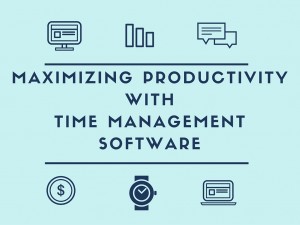 What do we need to increase productivity of the employees with time management?
We need to control, track and analyze the employees’ time, develop their potential bymonitoring their performance and regulating them. This does not only increase the productivity of the employees, it increases the productivity of the company as a whole, reduces staff costs, improves job-costing. Head of the company/department/team can easily plan future projects according to the timesheet, assign employees to tasks, check their statuses, approve leave requests etc.
How to make this process easy and track everything in one place?
There is no need to do tons of paperwork in order to be aware of what your employees are doing at the moment or to track your tasks, besides that nowadays paperwork is no more a secure way to keep your documentary. Spreadsheets are better, but too loaded and frustrating when you try to put everything in order.
HR management software is the answer. It provides a centrally stored information cloud for all your employee data, files and notes. This makes the information approachable and easy to manage. Time managing software has the ability to help employees capture their time spent on various projects and tasks, giving managers greater visibility of working day of the employee.
Kpi.com’s HR Management tool offers employee profiles and self-service, systematic Record-keeping, Recruitment, Attendance Tracking and Productivity monitoring. Employees can directly view their attendance and requests for leave can be requested and approved automatically. In addition the software can be customized to suit your company more ideally whether you have a large company or a small enterprise.
What do we need to increase productivity of the employees with time management?
We need to control, track and analyze the employees’ time, develop their potential bymonitoring their performance and regulating them. This does not only increase the productivity of the employees, it increases the productivity of the company as a whole, reduces staff costs, improves job-costing. Head of the company/department/team can easily plan future projects according to the timesheet, assign employees to tasks, check their statuses, approve leave requests etc.
How to make this process easy and track everything in one place?
There is no need to do tons of paperwork in order to be aware of what your employees are doing at the moment or to track your tasks, besides that nowadays paperwork is no more a secure way to keep your documentary. Spreadsheets are better, but too loaded and frustrating when you try to put everything in order.
HR management software is the answer. It provides a centrally stored information cloud for all your employee data, files and notes. This makes the information approachable and easy to manage. Time managing software has the ability to help employees capture their time spent on various projects and tasks, giving managers greater visibility of working day of the employee.
Kpi.com’s HR Management tool offers employee profiles and self-service, systematic Record-keeping, Recruitment, Attendance Tracking and Productivity monitoring. Employees can directly view their attendance and requests for leave can be requested and approved automatically. In addition the software can be customized to suit your company more ideally whether you have a large company or a small enterprise.
 5 Key Benefits of using time management software:
5 Key Benefits of using time management software:
- Concentration: Increases employee efficiency and engagement. When the employees can track their tasks, they will be more focused on their work, they will know how much time is left and what ongoing tasks do they have.
- Exporting data. Detailed reports can be generated in PDF and Excel format, so you can save them and print if there is such need.
- Resources adjusting. You can easily see the time spent on a project, the overall picture of the processes, which can help you prioritize them, add more resources to a project that needs more attention or vice versa.
- Attendance tracking allows you to manage employees and their schedules, leave types, leave allowances, daily attendance, employee time tracking, holidays and even integrate it with biometric time tracking devices, ensuring accurate salary payments and performance appraisals.
- Time management software is suitable for businesses of all sizes with plenty benefits and advantages provided by the available options.
You can watch a brief demo video of kpi.com’s HRMS tool here https://youtu.be/swYk62gTCwA
Read more information here: https://www.kpi.com/hrms/
What to Consider in Buying Accounting Tools for Non-Profit Organizations
Published Date : October 19, 2015
There are a lot of accounting tools available in the market. Most of the accounting tools are intended to be used by companies who are intended to make the profit. However, if you are operating in a non-profit industry, there are some nuances which you should consider before buying an accounting software.
As you know, many aspects of non-profit and profit organizations differ when it comes to bookkeeping and tax reporting. The major differences arise in cost allocations and reporting the expenses.
Non-profit organizations need to categorize expenses across management, fundraising and operational areas. Your accounting tool should be able to allocate expenses by various functional areas. For example, you might decide that administrative tasks might take up to 30 percent of your office space.
By allocating those costs, you will be able to know how much a certain fundraising activity actually costs. There are several standards available in finding out and applying direct/indirect and overhead costs. Consult with your accountant or your financial advisor to determine which approach and standards suit you best.
Also, the revenue of non-profit organizations will be different. Different countries have different accounting standards of what should be considered as a revenue. The standards include the treatment of unrestricted and restricted funds, donated goods, and in-kind contributions.
Coming to the reports, there are special reports that may be required by non-profit organizations. The accounting software should be able to show donor contribution reports and donation statements. There are also special forms (form 990) that might be required according to the laws of each country.
Kpi.com Online Accounting Solution supports unique needs of non-profit organizations. There is an ability to create different budgets: functional budgets, budgets of profit and loss statements, budgets by departments and so on. You can also view donation reports and dashboards. Sign-up in order to learn more.
What are the benefits of using online accounting software?
Published Date : October 19, 2015
You have a small business. You are all growing. If you think that it's time to consider switching your accounting software, you can choose to switch to online accounting solutions from your old legacy desktop applications. You might think that it is not safe to use online alternatives. You might also think that they are costly. However, they offer a lot of benefits, that cannot be undervalued. If you choose the right accounting software, it will help to grow your business.
Easy to Use User Interface
Web-based applications are designed to be useful. They are designed to be used by a lot of people, not only accountants. If you buy web based accounting software, you will enjoy usability and most importantly, you will be able to view reports, or post invoice yourself.
Security
Online accounting systems offer additional layers of security, compared to desktop legacy systems.
Firstly, nobody will be able to access your files without your permission. Secondly, because the web-based applications are hosted in the cloud, your company will be free from worrying about physical damage caused to your computers and hardware. You can read about security provided by cloud applications here.
Thirdly, if you choose the right accounting software provider, you will not be worrying about stolen passwords or hacker attacks.
Cost
You might think that you will be paying more with SaaS model, but in fact, you won't. Yes, your credit card will be charged every month. However, you will be saving on other things. Firstly, you will be saving on hiring an accountant who can use Quickbooks or other desktop software. Your web based accounting solution can be used by all accountants. Secondly, with web based ERP applications, such as kpi.com, you will not be worrying about integrating reports from one department to another. ERP applications support all your workflow needed, and there will not be a need to buy a separate accounting solution.
Real-time Information
You will be able to view what is happening with your company in real time. Knowing your financial position in real time, will help you to make better management decisions, thus, you can concentrate on providing excellent value for customers as a company.
There are lots of more benefits, including, improved customer service of cloud-based companies, and continuous upgrades.
What are the main problems of ERP users and how to solve them?
Published Date : October 9, 2015
Deploying an ERP software for a business may be troublesome which may initially cause a lot of inconveniences but can later on bring you the long-term benefits. In this post, I will like to discuss three main problems which ERP users may face during the implementation process and try to offer some solutions to them.
- Getting support/training from the provider to implement the software
Once the ERP software is purchased, many of its users have problems understanding and finding the needed functions. In such cases, an ERP provider usually supports its customers with online support, email and even provide trainings for free. However, sometimes users don't even know how to contact the support team and if they send an email, they wait some hours to get questions answered. As a result, the customer and its users loose time (a lot of time) deploying the software until they are fully familiar with the software. As you know, time is money!
What should you do in such cases?
- go to the website of your software and there you can find the Contact Us page.
- ask your administrator about the way how you can contact the support team of the software faster. Your administrator or CEO should have the contact details of the support people since during the evaluation process, ERP providers keep in touch with their potential customers.
- ask the support people to provide a demo training, if you find their user guides, blogs and videos not very helpful.
- Random glitches
Any software can have issues ranging from small, unnoticeable, to big annoying problems. For an ERP solution, even a small glitch can cause inconveniences and even delays in the business workflows.
What you should do?
- first of all, do not panic. Nothing is ideal. However, make sure that it is a malfunction and report it to the provider.
- After you report it, ask for other workarounds so that you can continue your tasks using the ERP software.
- Do not forget to get estimates on when the problem will be resolved.
- Need for a customization
Every business is special, so is yours. ERP providers cannot develop a global software that suits every business procedure. Sometimes, after implementing the software in your company, you find that you need something changed or something else developed as a new feature. Customizations are usually chargeable, but the benefits of having a customized ERP software outweighs all the costs.
What can you do?
- before making a decision to go with a certain software, test it properly. You may not be able to check all the functions from scratch, however, take an advice from the provider about the costs of implementing a new feature.
- when the customization is approved by you and the provider, document it properly to be as detailed as possible. Documentation is done by the ERP provider.
- once the new feature is available, check all the points and make sure it meets your expectations.
Difficult Clients - What Makes Them So Hard to Deal With?
Published Date : October 8, 2015
If you are an owner of a small business, you have to deal with various clients regularly. Sometimes you work out well. Sometimes you don't. There are some clients that are almost impossible to work with.
Who are those clients? Let's try to identify who are those clients whom you can't work with at all. Let's figure out why they are problems.
 Clients who know nothing at all
These are the clients who ask too much questions constantly, hinder your work, interrupt you from important meetings and emails, because they have a lot of questions about your services or products. Sometimes, you have to explain everything from basics, like you do for a child. Usually, these are the old people who are far behind the technology, and don't know basic stuff. You waste a lot of time on them, you waste your time, you waste their time.
How to deal with such clients
In order to deal with that kind of clients, you need to be clear. You need to explain that, even when you talk 24/7 on the phone, their problems don't get solved. You are being ineffective. So that way, they are losing their own money. Tell them the rules of the game. Tell them that they can't call you more than once a day, to ask simple questions that you've answered just yesterday. You have to establish rates, sometimes. Sometimes, giving out just well written simple instructions may be enough
Clients who don't know what they want
Some clients don't give any guidance at all. Moreover, they perfectly disappear at times when you need them. They aren't just present at meeting, important emails and phone calls. At last, their lack of organization becomes your problem, especially, when deadlines are tough.
How to deal with those clients
This is the problem that most of us face today. We don't have time for anything. Even answering the questions from the company from which we ordered stuff. This is our common problem. However, we may avoid risks of silent clients by signing clear contracts at the beginning. Or by explaining them the fact that, we can't slow down this project any more, we have more priorities coming
Clients who don't respect us
This happens most of the times. You explain, they don't listen. They don't rely on your expertise. They don't trust you. Even if they trust you, they don't let you do your own job.
How to deal with those clients
Tell them that if you need a surgery, you don't watch a YouTube video and make yourself a surgery. You straightly go the doctor. Sometimes you have to be polite, but strict in those areas.
Clients who don't want to spend money
They agree for everything at the beginning, but when it comes to payment, they disappear. They may disappear forever, or they may be slow with payment. Some people, may try to re-negotiate, and try to redo everything all over. These are the clients who are the hardest to tackle with. They want to pay once, and re-do one stuff forever until it gets perfect.
How to deal with those clients
Make sure to always sign written contracts with lawyers present in front of them. You have to secure yourself. You have to secure your employees, your company and your business. You need to have proper documentation before negotiating. Tell them clearly when the service will be implemented. Tell them when you want to receive money. Explain what happens if they want to change stuff.
Conclusions
Clarity is the king. Make sure to be clear from the beginning. Make sure to be polite, but strict when it comes to effectively utilizing your resources.
Clients who know nothing at all
These are the clients who ask too much questions constantly, hinder your work, interrupt you from important meetings and emails, because they have a lot of questions about your services or products. Sometimes, you have to explain everything from basics, like you do for a child. Usually, these are the old people who are far behind the technology, and don't know basic stuff. You waste a lot of time on them, you waste your time, you waste their time.
How to deal with such clients
In order to deal with that kind of clients, you need to be clear. You need to explain that, even when you talk 24/7 on the phone, their problems don't get solved. You are being ineffective. So that way, they are losing their own money. Tell them the rules of the game. Tell them that they can't call you more than once a day, to ask simple questions that you've answered just yesterday. You have to establish rates, sometimes. Sometimes, giving out just well written simple instructions may be enough
Clients who don't know what they want
Some clients don't give any guidance at all. Moreover, they perfectly disappear at times when you need them. They aren't just present at meeting, important emails and phone calls. At last, their lack of organization becomes your problem, especially, when deadlines are tough.
How to deal with those clients
This is the problem that most of us face today. We don't have time for anything. Even answering the questions from the company from which we ordered stuff. This is our common problem. However, we may avoid risks of silent clients by signing clear contracts at the beginning. Or by explaining them the fact that, we can't slow down this project any more, we have more priorities coming
Clients who don't respect us
This happens most of the times. You explain, they don't listen. They don't rely on your expertise. They don't trust you. Even if they trust you, they don't let you do your own job.
How to deal with those clients
Tell them that if you need a surgery, you don't watch a YouTube video and make yourself a surgery. You straightly go the doctor. Sometimes you have to be polite, but strict in those areas.
Clients who don't want to spend money
They agree for everything at the beginning, but when it comes to payment, they disappear. They may disappear forever, or they may be slow with payment. Some people, may try to re-negotiate, and try to redo everything all over. These are the clients who are the hardest to tackle with. They want to pay once, and re-do one stuff forever until it gets perfect.
How to deal with those clients
Make sure to always sign written contracts with lawyers present in front of them. You have to secure yourself. You have to secure your employees, your company and your business. You need to have proper documentation before negotiating. Tell them clearly when the service will be implemented. Tell them when you want to receive money. Explain what happens if they want to change stuff.
Conclusions
Clarity is the king. Make sure to be clear from the beginning. Make sure to be polite, but strict when it comes to effectively utilizing your resources.
The Ultimate Guide to Cloud ERP Software - Concepts and Definitions
Published Date : October 8, 2015
What is Cloud ERP
Enterprise Resource Planning software is a bit outdated term for business applications that support everyday activities of a company. ERP systems were built in a company's own server infrastructure and included mainly the modules like purchasing and inventory management.
Today, the ERP software definition has moved forward to imply the cloud web- based SaaS applications which support a wide variety of activities including project management, HR management, accounting and finance, payroll and more.
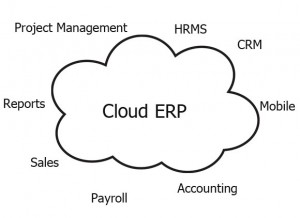 What Does the Cloud Imply?
In the past, cloud simply meant virtual servers located on distant places that can be accessed and managed through the internet. It simply meant that your data is stored somewhere in oceans, on the physical servers that you had to outsource. When it comes to business needs, that way, storing your data on the cloud gives you capabilities of managing your data real time without worrying about installing additional infrastructure on premises.
But when it comes to business applications, cloud computing simply means a single application that can be accessed through the browser from any location. It implies Software as a Service model, where you have to buy for using a software per user, per service basis.
The following video demonstrates the cloud ERP systems the most:
[embed]http://www.youtube.com/watch?v=ae_DKNwK_ms[/embed]
Benefits of Cloud ERP Software
There are a lot of benefits of implementing cloud ERP solutions in companies. Those benefits can be divided to technical benefits and benefits from the side of people.
Technical benefits include the fact that Cloud ERP solutions are accessible from anywhere. You can use them whether you are on a road, in the office, or at home. Moreover, companies can view and analyze the real-time data from the cloud, with any device available. This saves time, resources, and fosters effective communication inside the team.
Moreover, there is an increased security with cloud applications. There are multiple levels of security provided by the most ERP vendors.
There are benefits from people too. People using cloud ERP software become more productive, therefore, the operational costs of the company are also decreased. Controlling and managing the teams becomes easier, as managers will know who is doing what at the moment.
The availability of support is another nature of cloud ERP systems, that benefits most companies in many ways.
What Does the Cloud Imply?
In the past, cloud simply meant virtual servers located on distant places that can be accessed and managed through the internet. It simply meant that your data is stored somewhere in oceans, on the physical servers that you had to outsource. When it comes to business needs, that way, storing your data on the cloud gives you capabilities of managing your data real time without worrying about installing additional infrastructure on premises.
But when it comes to business applications, cloud computing simply means a single application that can be accessed through the browser from any location. It implies Software as a Service model, where you have to buy for using a software per user, per service basis.
The following video demonstrates the cloud ERP systems the most:
[embed]http://www.youtube.com/watch?v=ae_DKNwK_ms[/embed]
Benefits of Cloud ERP Software
There are a lot of benefits of implementing cloud ERP solutions in companies. Those benefits can be divided to technical benefits and benefits from the side of people.
Technical benefits include the fact that Cloud ERP solutions are accessible from anywhere. You can use them whether you are on a road, in the office, or at home. Moreover, companies can view and analyze the real-time data from the cloud, with any device available. This saves time, resources, and fosters effective communication inside the team.
Moreover, there is an increased security with cloud applications. There are multiple levels of security provided by the most ERP vendors.
There are benefits from people too. People using cloud ERP software become more productive, therefore, the operational costs of the company are also decreased. Controlling and managing the teams becomes easier, as managers will know who is doing what at the moment.
The availability of support is another nature of cloud ERP systems, that benefits most companies in many ways.
Does Cloud ERP need to be updated?
Cloud ERP systems are updated automatically from vendors. You do not need to install or upgrade anything.
Are Customizations Available?
Cloud ERP Systems are flexible enough and offer a lot of additional customizations for your business. You can customize small stuff such as your invoice templates, or you can customize the software to fit your own workflows inside the company.
Sign up for a Free Trial in order to learn more!
How to Choose an ERP Software for a Professional Services Industry
Published Date : October 7, 2015
How is Professional Service industry different from others? Is there anything we are missing when we are trying to choose the right software? Let's try to answer those questions.
Well, the answer is, it really depends.
If you are working in a professional services industry, you must know the importance of choosing the right software for your business.
When we narrow it down, professional services industry is much different, much flexible and unpredictable comparing to production, manufacturing, or other industries. Because each client receives different products or projects. You need to build/design/consult/engineer different stuff for different people. Therefore, managing people and clients will also be different. Comparing to manufacturing and production industries, where you have predefined known set of workflow or tasks, professional services industry tasks and workflow is unknown or flexible. Moreover, the services you are building might require long term relationship and on-going support from your company.
 Clearly, as a professional services company you may need something more than just tracking time. You need to predict demand, allocate budget and resources, manage different cost centers, and bill your customers. At the same time, you need a system for managing your customer issues on an ongoing basis. You will have your own supply chain including activities in: sales, planning, delivery, and customer service.
The ERP software you are going to choose has to be integrated. Since all your data is focused among the customers, you will need a software which will help you to analyze how we got that customer, what projects we did for this customer, what kind of invoices are there... etc... All information regarding that customer has to in one place.
There are some must have tools that need to present in an ERP software for Professional Services industry. And the first one is...
Clearly, as a professional services company you may need something more than just tracking time. You need to predict demand, allocate budget and resources, manage different cost centers, and bill your customers. At the same time, you need a system for managing your customer issues on an ongoing basis. You will have your own supply chain including activities in: sales, planning, delivery, and customer service.
The ERP software you are going to choose has to be integrated. Since all your data is focused among the customers, you will need a software which will help you to analyze how we got that customer, what projects we did for this customer, what kind of invoices are there... etc... All information regarding that customer has to in one place.
There are some must have tools that need to present in an ERP software for Professional Services industry. And the first one is...
Project Management
Look for robust project management module in an ERP software. The project management software should have an ability to manage different projects in different multiple locations. A project manager needs to have an ability to view the overall picture of the project on various dashboards. And most important the project management module should be integrated with Accounting module. There should be an ability to assign different cost centers to different projects. If your employees are paid hourly, there should be an ability for employees to fill a timesheet and connect it to their payroll. Also, don't forget about gannt chart and budgeting capabilities.
 Professional service firms need robust project management processes and software. A single engagement may be comprised of multiple projects in multiple locations. An engagement manager needs visibility into each project, as well as a “picture,” a dashboard of the engagement as a whole in terms of progress to date, completed tasks, and outstanding issues.
Professional service firms need robust project management processes and software. A single engagement may be comprised of multiple projects in multiple locations. An engagement manager needs visibility into each project, as well as a “picture,” a dashboard of the engagement as a whole in terms of progress to date, completed tasks, and outstanding issues.
Accounting and Payroll
This is the most important part. Maybe this is the single most important part you need to be paying attention to when buying an ERP package. Your billing process can be per client once or even per any engagement-project implementation or customer service. Services you are providing may be provided on a fixed fee/quotation basis, or expense basis or percentage of completion basis.Billing rates can also be different depending on who is performing the task - the senior consultant or a junior employee.
Most importantly, if your company collects and applies different invoices to different activities, the system should have capabilities of matching those amounts. There should be expense claims regarding staff assignments or travel arrangements made. And all those standards should be connected with Project Management activities.
Staff Management
Staff management is as important as Project Management and Accounting. Choose a software which will enforce the employee productivity. Your system must be able to track time and encourage users to work efficiently. Moreover, there should be a proper mechanism to manage leave requests and performance appraisals.
Sales and CRM and Customer Service
Look for integrated CRM software with emailing capabilities. As a service industry, you might receive all your customer complaints through email. Look for issue management or ticket management capabilities. The CRM part should be customizable, as different companies have different processes of gaining and managing clients.
Conclusions
Depending on a type of your organization, you need to pay a careful attention to choosing the right tools: including an integrated project management, accounting and payroll, staff management, and CRM. When you have those tools in place, go for it! Sign up for a free trial, test it, work on it.
The following video demonstrates how professional services industries can benefit from kpi.com:
[embed]https://youtu.be/JijIDeHngL4[/embed]



 After saving new custom field will be available in the Meeting Minutes tab.
After saving new custom field will be available in the Meeting Minutes tab. Project Management
Project Management






 Lead Flow.
This KPI essentially needs to be measured by all sales departments as it shows the quantity of people that are interested in the productservice. This indicator needs to be measured each month/quarter/half-year/year. Another criteria is where these leads came from. For example, how many of them came from social media, or by referral, newspaper or other channels. This way you can analyze and decide what channel is providing you more leads and focus on it.
Extra: If you need the detailed analysis of leads, you can also track how many leads converted to customers and which channel brings more customers. It is obvious that more leads = more customers, but if you want to emphasize on the leads tracking, you will definitely need this information. This will be another KPI in sales, it is called Lead-to-Customer Conversion Rate. It is measured in percents. Calculation is simple: the number of new customers divided by the number of qualified leads. This way you will know the rate at which your leads become customers and analyze what actions you need to perform improve your lead-to-sale conversion rate.
What is a qualified lead? A qualified lead is more than just contact details. It includes further information on the person or the company they represent, information that qualifies them for a certain product.
Lead Flow.
This KPI essentially needs to be measured by all sales departments as it shows the quantity of people that are interested in the productservice. This indicator needs to be measured each month/quarter/half-year/year. Another criteria is where these leads came from. For example, how many of them came from social media, or by referral, newspaper or other channels. This way you can analyze and decide what channel is providing you more leads and focus on it.
Extra: If you need the detailed analysis of leads, you can also track how many leads converted to customers and which channel brings more customers. It is obvious that more leads = more customers, but if you want to emphasize on the leads tracking, you will definitely need this information. This will be another KPI in sales, it is called Lead-to-Customer Conversion Rate. It is measured in percents. Calculation is simple: the number of new customers divided by the number of qualified leads. This way you will know the rate at which your leads become customers and analyze what actions you need to perform improve your lead-to-sale conversion rate.
What is a qualified lead? A qualified lead is more than just contact details. It includes further information on the person or the company they represent, information that qualifies them for a certain product.
 Customer/Sales Flow.
Similar to Leads Flow this KPI shows how many customers the firm has gained during the current month/quarter/half-year/year. It helps you evaluate company’s success, as one of the biggest goals of every firm is maximizing income which can be achieved by increasing the number of customers/sales.
Customer/Sales Flow.
Similar to Leads Flow this KPI shows how many customers the firm has gained during the current month/quarter/half-year/year. It helps you evaluate company’s success, as one of the biggest goals of every firm is maximizing income which can be achieved by increasing the number of customers/sales.
 Cost per lead
Also called CPL. Every action you commit in order to attract new leads has its cost. It can be, for example, the cost of the landing page web design, social media advertisement or TV commercial. You can calculate the cost per lead performance indicator by summing up all your monthly (or any other period needed) marketing and advertising expenses and divide them by the number of monthly new leads. Don’t forget to include the salary of your marketing workers (according to the appropriate period of work). The lower is the indicator - the better is your current situation.
Extra: Again, if you need more detailed information, you will need to measure another key performance indicator - Cost Per Conversion. Just as CPL it indicates everything you spend to convert lead to sale. It will be much higher than the previous KPI.
Calculation: Sum of all your monthly marketing costs divided by the number of monthly new customers or sales.
Here, you can measure the Average Conversion Time KPI, in addition. How much time it took for a lead to become a customer.
Customer turnover rate
Customer turnover rate stands for how many of your customers refused to use your product/service. Also called as churn rate. Company should analyze the reasons why customers quit using their services. Was it because of the high price, bad customer service or a greater deal from your competitor.
Calculation: Number of customers that left / Total number of customers * 100%
Cost per lead
Also called CPL. Every action you commit in order to attract new leads has its cost. It can be, for example, the cost of the landing page web design, social media advertisement or TV commercial. You can calculate the cost per lead performance indicator by summing up all your monthly (or any other period needed) marketing and advertising expenses and divide them by the number of monthly new leads. Don’t forget to include the salary of your marketing workers (according to the appropriate period of work). The lower is the indicator - the better is your current situation.
Extra: Again, if you need more detailed information, you will need to measure another key performance indicator - Cost Per Conversion. Just as CPL it indicates everything you spend to convert lead to sale. It will be much higher than the previous KPI.
Calculation: Sum of all your monthly marketing costs divided by the number of monthly new customers or sales.
Here, you can measure the Average Conversion Time KPI, in addition. How much time it took for a lead to become a customer.
Customer turnover rate
Customer turnover rate stands for how many of your customers refused to use your product/service. Also called as churn rate. Company should analyze the reasons why customers quit using their services. Was it because of the high price, bad customer service or a greater deal from your competitor.
Calculation: Number of customers that left / Total number of customers * 100%
 Sales volume
Sales performed can be measured by a specific period of time, for example: year. half-year. quarter, month, week, day. This is the most informative key performance indicator for the sales department. Analyzing this indicator we can reveal answers to important questions as “How to improve sales results” or “How to increase sales”. By looking through the growth/recession of sales during the specific period of time we can find out what actions, made by us led to the growth or downturn of the sales volume.
In conclution, here are some interesting and motivational statistics that may help sales managers:
Sales volume
Sales performed can be measured by a specific period of time, for example: year. half-year. quarter, month, week, day. This is the most informative key performance indicator for the sales department. Analyzing this indicator we can reveal answers to important questions as “How to improve sales results” or “How to increase sales”. By looking through the growth/recession of sales during the specific period of time we can find out what actions, made by us led to the growth or downturn of the sales volume.
In conclution, here are some interesting and motivational statistics that may help sales managers:
 Think about that, good luck in your business!
Image credentials: http://www.hoopla.biz/#!motivation-station/c1g4s
https://www.nasp.com/
Think about that, good luck in your business!
Image credentials: http://www.hoopla.biz/#!motivation-station/c1g4s
https://www.nasp.com/
 CRM
Import contact from CSV is optimized for speed and performance.
CRM
Import contact from CSV is optimized for speed and performance.
 Accounting
Purchase order receive type field has been added. Now you can receive purchase order by quantity and by amount.
Once you click on Receive button total quantity of the purchased item will be added to Receive field. In the Receive field you can change the quantity of received items that allow you receive partial amounts, or even more than ordered.
Accounting
Purchase order receive type field has been added. Now you can receive purchase order by quantity and by amount.
Once you click on Receive button total quantity of the purchased item will be added to Receive field. In the Receive field you can change the quantity of received items that allow you receive partial amounts, or even more than ordered.
 Added discounts into add/edit product form - shows discounts list from Accounting settings, wich makes it easier to access the discounts page and set up discounts.
Added discounts into add/edit product form - shows discounts list from Accounting settings, wich makes it easier to access the discounts page and set up discounts.
 Added new Currency Widget
Added multi currency option into Balance Sheet report, now you can choose a currency from the dropdown menu.
Added new Currency Widget
Added multi currency option into Balance Sheet report, now you can choose a currency from the dropdown menu.
 Payroll
Manage sending notification to employees
HRMS
Employee list - option to quickly change or add phone numbers. Double tap on the phone number to edit it. Click on the check mark to save.
Payroll
Manage sending notification to employees
HRMS
Employee list - option to quickly change or add phone numbers. Double tap on the phone number to edit it. Click on the check mark to save.
 Employee leave allowance - option to select previous years added.
Certificates - option to attach employee image docs to certificates added.
New certificate templates added:
Employee leave allowance - option to select previous years added.
Certificates - option to attach employee image docs to certificates added.
New certificate templates added:
 Existing position names can't be saved to avoid duplication.
Attendance report - PDF export option added.
Customize Recruitment Countries and Embassies option added.
Vacancy form - country, embassy, gender, contract type etc. fields added
If you have questions related to the upgrades, please contact our customer support team.
E-mail: support@kpi.com
Skype: kpi.com
Phone: (UK) +44 (0) 207 096 1245
(UAE) +971 4 424 3033
(US) +1 646 844 33 30
Existing position names can't be saved to avoid duplication.
Attendance report - PDF export option added.
Customize Recruitment Countries and Embassies option added.
Vacancy form - country, embassy, gender, contract type etc. fields added
If you have questions related to the upgrades, please contact our customer support team.
E-mail: support@kpi.com
Skype: kpi.com
Phone: (UK) +44 (0) 207 096 1245
(UAE) +971 4 424 3033
(US) +1 646 844 33 30



 3. Buffer is also a great company that values customers. Buffer's cofounder Leo Widrich responded with a real help to a user's critique.
3. Buffer is also a great company that values customers. Buffer's cofounder Leo Widrich responded with a real help to a user's critique.
 4. Dreamhost even goes beyond offering totally free accounts for non-profit companies. The company treats all issues/requests from non-profit companies as paid ones.
5. My favorite one is Rackspace. It is a company which has hired really great people for serving customers. During a troubleshooting call, the customer said that he was very hungry. The rep from Rackspace ordered him a free pizza during the call.
4. Dreamhost even goes beyond offering totally free accounts for non-profit companies. The company treats all issues/requests from non-profit companies as paid ones.
5. My favorite one is Rackspace. It is a company which has hired really great people for serving customers. During a troubleshooting call, the customer said that he was very hungry. The rep from Rackspace ordered him a free pizza during the call.

 Every area of business has specific metrics that should be monitored, measured and analyzed – marketers track campaign statistics, sales teams monitor new opportunities and leads, and HR managers control the turnover rate.
Not all metrics are necessary Key Performance Indicators. And not all KPIs need to be measured and significant for the company. Various determination methods help us to define what Key Performance Indicators we need to take into account in our specific area of activity.
Every area of business has specific metrics that should be monitored, measured and analyzed – marketers track campaign statistics, sales teams monitor new opportunities and leads, and HR managers control the turnover rate.
Not all metrics are necessary Key Performance Indicators. And not all KPIs need to be measured and significant for the company. Various determination methods help us to define what Key Performance Indicators we need to take into account in our specific area of activity.
 To evaluate the relevance of a KPI is to use the SMART method. The letters in the acronym stand for specific, measurable, attainable, relevant, timed. In other words, they should answer the following questions:
To evaluate the relevance of a KPI is to use the SMART method. The letters in the acronym stand for specific, measurable, attainable, relevant, timed. In other words, they should answer the following questions:
 Lagging KPIs are focused on the past. They measure the output. For example, in HR the “Turnover rate” is a lagging KPI. Lagging KPIs tell us story about the current state of your HR, but they don’t tell you how to change this state. While leading KPIs are focused on the future. Leading KPIs measure the input that should be introduced to achieve better results. KPIs are important for analysis and monitoring: they tell you different stories about your objectives.
Different types of performance measure: KRIs, PIs, RIs, KPIs.
The relationship between these four performance measures can be compared to the structure of an onion - multilayered. The outside layer describes the overall condition of the objective. The inner layers show the performance and result indicators, and the core is where the Key Performance Indicators are.
Lagging KPIs are focused on the past. They measure the output. For example, in HR the “Turnover rate” is a lagging KPI. Lagging KPIs tell us story about the current state of your HR, but they don’t tell you how to change this state. While leading KPIs are focused on the future. Leading KPIs measure the input that should be introduced to achieve better results. KPIs are important for analysis and monitoring: they tell you different stories about your objectives.
Different types of performance measure: KRIs, PIs, RIs, KPIs.
The relationship between these four performance measures can be compared to the structure of an onion - multilayered. The outside layer describes the overall condition of the objective. The inner layers show the performance and result indicators, and the core is where the Key Performance Indicators are.
 When we have the Key Performance Indicators measured, the data itself can be difficult to percept and analyze. This is the reason we need to use data visualization which makes the process simple and understandable, increasing efficiency of the received data by focusing on important items, revealing trends, tendencies and allowing to trace over time changes.
Waterfall Chart. A waterfall chart is a form of data visualization that helps in understanding the cumulative effect of sequentially introduced positive or negative values. The waterfall chart is also known as a flying bricks chart or Mario chart due to the apparent suspension of columns (bricks) in mid-air.
When we have the Key Performance Indicators measured, the data itself can be difficult to percept and analyze. This is the reason we need to use data visualization which makes the process simple and understandable, increasing efficiency of the received data by focusing on important items, revealing trends, tendencies and allowing to trace over time changes.
Waterfall Chart. A waterfall chart is a form of data visualization that helps in understanding the cumulative effect of sequentially introduced positive or negative values. The waterfall chart is also known as a flying bricks chart or Mario chart due to the apparent suspension of columns (bricks) in mid-air.
 Sparkline Chart. A sparkline is a very small line chart, typically drawn without axes or coordinates. It presents the general shape of the variation (typically over time) in some measurement. Sparklines are small enough to be embedded in text, or several sparklines may be grouped together as elements of a small multiple.
Sparkline Chart. A sparkline is a very small line chart, typically drawn without axes or coordinates. It presents the general shape of the variation (typically over time) in some measurement. Sparklines are small enough to be embedded in text, or several sparklines may be grouped together as elements of a small multiple.
 Bar Chart or Bar Graph is a chart that presents grouped data with rectangular bars with lengths proportional to the values that they represent. The bars can be plotted vertically or horizontally.
Bar Chart or Bar Graph is a chart that presents grouped data with rectangular bars with lengths proportional to the values that they represent. The bars can be plotted vertically or horizontally.

 Bullet Graph. A bullet graph is a variation of a bar graph.It serves as a replacement for dashboard gauges and meters. Bullet graphs were developed to overcome the fundamental issues of gauges and meters: they typically display too little information, require too much space, and are cluttered with useless and distracting decoration.
Bullet Graph. A bullet graph is a variation of a bar graph.It serves as a replacement for dashboard gauges and meters. Bullet graphs were developed to overcome the fundamental issues of gauges and meters: they typically display too little information, require too much space, and are cluttered with useless and distracting decoration.
 Also, Pie Chart. A pie chart (or a circle chart) is a circular statistical graphic, which is divided into slices to illustrate numerical proportion. In a pie chart, the arc length of each slice (and consequently its central angle and area), is proportional to the quantity it represents.
Also, Pie Chart. A pie chart (or a circle chart) is a circular statistical graphic, which is divided into slices to illustrate numerical proportion. In a pie chart, the arc length of each slice (and consequently its central angle and area), is proportional to the quantity it represents.
 Tips for KPI Data Visualization
Tips for KPI Data Visualization
 Percentage of Completed Planned – This KPI describes the percentage of work which was planned to be completed by the Reporting Date.
Calculation:
% Completed Planned = PV / BAC (Budget at Completion)
Percentage of Completed Actual – The percentage of work which was actually completed by the Reporting Date.
Calculation:
% Completed Actual = AC / EAC (Estimate at completion)
Deviation of planned budget (%) This KPI shows the variation of the planned budget (or cost) is the difference in total costs between the planned and actual budget.
Calculation:
Actual budget/ Planned Baseline x 100
Deviation of planned hours of work (%) – Just like the first KPI in this article, this is the deviation of the planned work is the difference in work hours between the planned baseline as compared against the actual statement of work.
Calculation:
Actual hours spent / Planned hours of work x 100%
Deviation of planned time schedule for project/program – The deviation of the planned time schedule is the difference in time between the planned baseline against the actual schedule.
Percentage of milestones missed – This KPI helps managers keep track of the percentage of projects that have missed milestones. Percentage of milestones as recorded in all projects/programs that have been missed. Identifying milestones and achieving goals are important to maintaining project. When too many milestones are not achieved or are shifted, employees may feel frustrated. Identifying when milestones are missed can help restart a project and mitigate similar challenges in the future.
Percentage of overdue project tasks – Percentage of the tasks that are not finished yet.
Calculation:
Quantity of the overdue tasks / Total quantity of tasks x 100%
Cost of managing processes – Costs of managing processes in a special period of time, usually based on the number of Full Time Equivalent personnel (FTEs) involved in management functions or processes.
Calculation:
Total cost for managing processes / Period of time
Performance Index (CPI) – Earned Value divided by the actual cost (BCWP/ACWP).
Cost Schedule Index (CSI) – Cost Performance Index times Schedule Performance Index (CPI x SPI). CSI measures the likelihood of recovery for project that is late and/or over budget
Cost Variance (CV) Earned Value minus the actual cost (BCWP-ACWP).
Estimate at Completion (EAC) – The actual cost of work performed (ACWP) plus the estimate to complete (ETC) for all of the remaining work.
Schedule Performance Index (SPI) – Earned Value divided by the planned value (BCWP/BCWS).
Schedule Variance (SV) – Earned Value minus the planned budget for the completed work (BCWP-BCWS).
Percentage of Completed Planned – This KPI describes the percentage of work which was planned to be completed by the Reporting Date.
Calculation:
% Completed Planned = PV / BAC (Budget at Completion)
Percentage of Completed Actual – The percentage of work which was actually completed by the Reporting Date.
Calculation:
% Completed Actual = AC / EAC (Estimate at completion)
Deviation of planned budget (%) This KPI shows the variation of the planned budget (or cost) is the difference in total costs between the planned and actual budget.
Calculation:
Actual budget/ Planned Baseline x 100
Deviation of planned hours of work (%) – Just like the first KPI in this article, this is the deviation of the planned work is the difference in work hours between the planned baseline as compared against the actual statement of work.
Calculation:
Actual hours spent / Planned hours of work x 100%
Deviation of planned time schedule for project/program – The deviation of the planned time schedule is the difference in time between the planned baseline against the actual schedule.
Percentage of milestones missed – This KPI helps managers keep track of the percentage of projects that have missed milestones. Percentage of milestones as recorded in all projects/programs that have been missed. Identifying milestones and achieving goals are important to maintaining project. When too many milestones are not achieved or are shifted, employees may feel frustrated. Identifying when milestones are missed can help restart a project and mitigate similar challenges in the future.
Percentage of overdue project tasks – Percentage of the tasks that are not finished yet.
Calculation:
Quantity of the overdue tasks / Total quantity of tasks x 100%
Cost of managing processes – Costs of managing processes in a special period of time, usually based on the number of Full Time Equivalent personnel (FTEs) involved in management functions or processes.
Calculation:
Total cost for managing processes / Period of time
Performance Index (CPI) – Earned Value divided by the actual cost (BCWP/ACWP).
Cost Schedule Index (CSI) – Cost Performance Index times Schedule Performance Index (CPI x SPI). CSI measures the likelihood of recovery for project that is late and/or over budget
Cost Variance (CV) Earned Value minus the actual cost (BCWP-ACWP).
Estimate at Completion (EAC) – The actual cost of work performed (ACWP) plus the estimate to complete (ETC) for all of the remaining work.
Schedule Performance Index (SPI) – Earned Value divided by the planned value (BCWP/BCWS).
Schedule Variance (SV) – Earned Value minus the planned budget for the completed work (BCWP-BCWS).
 Deciding what KPIs in Project Management you need to measure and analyze, don’t forget that effective KPIs should be S.M.A.R.T. (Specific, Measurable, Attainable, Realistic, Time-based) and:
Deciding what KPIs in Project Management you need to measure and analyze, don’t forget that effective KPIs should be S.M.A.R.T. (Specific, Measurable, Attainable, Realistic, Time-based) and:
 Actual Cost (AC). This KPI indicates how much money you have spent on a project as to date. To calculate it you need too sum up all the project-related expenses you’ve used to date. (Also called as Actual Cost of Work Performed (ACWP) – The sum of actual costs of activities that are completed).
Planned Value (PV). The planned value is the estimated cost for your project activities planned/scheduled as of reporting date.
Can be calculated by these formulas:
PV = (the hours left scheduled on the project) X (project worker’s hourly rate)
PV = (Planned % of tasks left to complete) X (project budget)
Project budget is calculated considering all the hours planned for the project, so use the time spent on tasks to calculate the Actual Cost spent on salaries, resources etc.
Also can be named as Budgeted Cost of Work Scheduled (BCWS) – The budgets of the activities that are planned or scheduled to be completed. It is a project management KPI that answers the question: how much cost should be spent on the project for the work that should be done up to a certain date according to your schedule.
Calculation:
BCWS = Total Budgeted Cost * Scheduled Project Percentage
Estimate at completion. Estimate at completion (EAC) shows the cost of the project as the project progresses.
How to calculate:
EAC = actual costs (AC) + budget at completion (BAC) – earned value (EV)
or
EAC = actual costs (AC) + estimate to complete (ETC)
Estimate to completion. Estimate to complete (ETC) is how much more money will need to be spent to complete the project.
ETC = estimate at completion (EAC) – actual costs (AC)
or
ETC = new estimates
Deviation of planned time schedule for project. The deviation of the planned time schedule is the difference in time between the planned baseline against the actual schedule.
How to measure:
Actual Schedule/ Planned Baseline x 100%
Deviation of planned budget. The deviation of the planned budget (cost) is the difference in costs between the planned baseline against the actual budget.
Resource utilization. Resource utilization measures how the time of team members is used while working on the project. It implies how much time are people working on billable activities compared to the time spent on non-billable tasks.
An excellent project dashboard gives a complete overview of the project and team performance. Depending on your goals, add to your KPI tracking dashboard accurate metrics that help you make informed decisions and to keep your hand on the pulse of all projects. Read the second part of the article KPIs in Project Management here.
Actual Cost (AC). This KPI indicates how much money you have spent on a project as to date. To calculate it you need too sum up all the project-related expenses you’ve used to date. (Also called as Actual Cost of Work Performed (ACWP) – The sum of actual costs of activities that are completed).
Planned Value (PV). The planned value is the estimated cost for your project activities planned/scheduled as of reporting date.
Can be calculated by these formulas:
PV = (the hours left scheduled on the project) X (project worker’s hourly rate)
PV = (Planned % of tasks left to complete) X (project budget)
Project budget is calculated considering all the hours planned for the project, so use the time spent on tasks to calculate the Actual Cost spent on salaries, resources etc.
Also can be named as Budgeted Cost of Work Scheduled (BCWS) – The budgets of the activities that are planned or scheduled to be completed. It is a project management KPI that answers the question: how much cost should be spent on the project for the work that should be done up to a certain date according to your schedule.
Calculation:
BCWS = Total Budgeted Cost * Scheduled Project Percentage
Estimate at completion. Estimate at completion (EAC) shows the cost of the project as the project progresses.
How to calculate:
EAC = actual costs (AC) + budget at completion (BAC) – earned value (EV)
or
EAC = actual costs (AC) + estimate to complete (ETC)
Estimate to completion. Estimate to complete (ETC) is how much more money will need to be spent to complete the project.
ETC = estimate at completion (EAC) – actual costs (AC)
or
ETC = new estimates
Deviation of planned time schedule for project. The deviation of the planned time schedule is the difference in time between the planned baseline against the actual schedule.
How to measure:
Actual Schedule/ Planned Baseline x 100%
Deviation of planned budget. The deviation of the planned budget (cost) is the difference in costs between the planned baseline against the actual budget.
Resource utilization. Resource utilization measures how the time of team members is used while working on the project. It implies how much time are people working on billable activities compared to the time spent on non-billable tasks.
An excellent project dashboard gives a complete overview of the project and team performance. Depending on your goals, add to your KPI tracking dashboard accurate metrics that help you make informed decisions and to keep your hand on the pulse of all projects. Read the second part of the article KPIs in Project Management here.
 In this article we will be talking about key performance indicators in HR. Human resources department is responsible for everything that is connected with hiring, managing, firing, sourcing, searching, tracking, benefiting, interviewing staff, payroll etc. No matter what size your business is, human resources department is a significant component of the firm’s efficiency.
The goal of HR management is to help the company achieve its mission by hiring the right people, training and managing them to reach progress.
It turns out that HR KPIs are one of the most exponential for the company. What KPIs does it include? There are more than 100 metrics, so let us observe the primary indicators.
Employee turnover. Simply this indicators show the number (or %) of employees that leave the firm and are replaces by others. For example, usually positions that need high-skilled personnel have low turnover when unskilled positions have high turnover as these workers can be easily replaced by others. Turnover rate is the percentage of employees in a workforce that leave during a certain period of time. It includes:
In this article we will be talking about key performance indicators in HR. Human resources department is responsible for everything that is connected with hiring, managing, firing, sourcing, searching, tracking, benefiting, interviewing staff, payroll etc. No matter what size your business is, human resources department is a significant component of the firm’s efficiency.
The goal of HR management is to help the company achieve its mission by hiring the right people, training and managing them to reach progress.
It turns out that HR KPIs are one of the most exponential for the company. What KPIs does it include? There are more than 100 metrics, so let us observe the primary indicators.
Employee turnover. Simply this indicators show the number (or %) of employees that leave the firm and are replaces by others. For example, usually positions that need high-skilled personnel have low turnover when unskilled positions have high turnover as these workers can be easily replaced by others. Turnover rate is the percentage of employees in a workforce that leave during a certain period of time. It includes:
 Retention. This group shows the ability of the firm to retain its employees. Preventable turnover means the loss of employees, reasons why they left and measures that may be taken to prevent the loss. They are:
Retention. This group shows the ability of the firm to retain its employees. Preventable turnover means the loss of employees, reasons why they left and measures that may be taken to prevent the loss. They are:
 Generally, they indicate how the employees are satisfied with the work conditions: training, development, promotion and awards opportunities, relationship with administration, managers and colleagues.
Payroll. Setting up KPI definitions for your Payroll is to determine which processes are critical to supporting the organization’s employees, it includes:
Generally, they indicate how the employees are satisfied with the work conditions: training, development, promotion and awards opportunities, relationship with administration, managers and colleagues.
Payroll. Setting up KPI definitions for your Payroll is to determine which processes are critical to supporting the organization’s employees, it includes:
 Key performance indicators reflect the performance of the organization or its department, it is a powerful tool to manage Human Resources. But using tons of KPIs will lead to confusion, not success, here the rule “the more – the better” doesn’t work. It is better to focus on a few of them. Your company may have different needs or criteria that are more important to measure. To gain expected and better results you should “Measure What Matters” (be S.M.A.R.T.) for you and your organization, so your HR department could benefit from using the KPIs information. Don’t forget that the target of KPIs is to lead to meeting company’s business goals.
Key performance indicators reflect the performance of the organization or its department, it is a powerful tool to manage Human Resources. But using tons of KPIs will lead to confusion, not success, here the rule “the more – the better” doesn’t work. It is better to focus on a few of them. Your company may have different needs or criteria that are more important to measure. To gain expected and better results you should “Measure What Matters” (be S.M.A.R.T.) for you and your organization, so your HR department could benefit from using the KPIs information. Don’t forget that the target of KPIs is to lead to meeting company’s business goals.
 How? Here is a list of the benefits of the performance appraisal system:
How? Here is a list of the benefits of the performance appraisal system:
 Undoubtedly, there are disadvantages in the performance appraisal system as nothing is ideal, but it provides a lot of useful information for the company and employee itself that can’t be acquired from other sources. Furthermore, years of experience show the efficiency of using performance appraisal system in practice.
Undoubtedly, there are disadvantages in the performance appraisal system as nothing is ideal, but it provides a lot of useful information for the company and employee itself that can’t be acquired from other sources. Furthermore, years of experience show the efficiency of using performance appraisal system in practice.
 What do we need to increase productivity of the employees with time management?
We need to control, track and analyze the employees’ time, develop their potential bymonitoring their performance and regulating them. This does not only increase the productivity of the employees, it increases the productivity of the company as a whole, reduces staff costs, improves job-costing. Head of the company/department/team can easily plan future projects according to the timesheet, assign employees to tasks, check their statuses, approve leave requests etc.
How to make this process easy and track everything in one place?
There is no need to do tons of paperwork in order to be aware of what your employees are doing at the moment or to track your tasks, besides that nowadays paperwork is no more a secure way to keep your documentary. Spreadsheets are better, but too loaded and frustrating when you try to put everything in order.
HR management software is the answer. It provides a centrally stored information cloud for all your employee data, files and notes. This makes the information approachable and easy to manage. Time managing software has the ability to help employees capture their time spent on various projects and tasks, giving managers greater visibility of working day of the employee.
Kpi.com’s HR Management tool offers employee profiles and self-service, systematic Record-keeping, Recruitment, Attendance Tracking and Productivity monitoring. Employees can directly view their attendance and requests for leave can be requested and approved automatically. In addition the software can be customized to suit your company more ideally whether you have a large company or a small enterprise.
What do we need to increase productivity of the employees with time management?
We need to control, track and analyze the employees’ time, develop their potential bymonitoring their performance and regulating them. This does not only increase the productivity of the employees, it increases the productivity of the company as a whole, reduces staff costs, improves job-costing. Head of the company/department/team can easily plan future projects according to the timesheet, assign employees to tasks, check their statuses, approve leave requests etc.
How to make this process easy and track everything in one place?
There is no need to do tons of paperwork in order to be aware of what your employees are doing at the moment or to track your tasks, besides that nowadays paperwork is no more a secure way to keep your documentary. Spreadsheets are better, but too loaded and frustrating when you try to put everything in order.
HR management software is the answer. It provides a centrally stored information cloud for all your employee data, files and notes. This makes the information approachable and easy to manage. Time managing software has the ability to help employees capture their time spent on various projects and tasks, giving managers greater visibility of working day of the employee.
Kpi.com’s HR Management tool offers employee profiles and self-service, systematic Record-keeping, Recruitment, Attendance Tracking and Productivity monitoring. Employees can directly view their attendance and requests for leave can be requested and approved automatically. In addition the software can be customized to suit your company more ideally whether you have a large company or a small enterprise.
 5 Key Benefits of using time management software:
5 Key Benefits of using time management software:
 Clients who know nothing at all
These are the clients who ask too much questions constantly, hinder your work, interrupt you from important meetings and emails, because they have a lot of questions about your services or products. Sometimes, you have to explain everything from basics, like you do for a child. Usually, these are the old people who are far behind the technology, and don't know basic stuff. You waste a lot of time on them, you waste your time, you waste their time.
How to deal with such clients
In order to deal with that kind of clients, you need to be clear. You need to explain that, even when you talk 24/7 on the phone, their problems don't get solved. You are being ineffective. So that way, they are losing their own money. Tell them the rules of the game. Tell them that they can't call you more than once a day, to ask simple questions that you've answered just yesterday. You have to establish rates, sometimes. Sometimes, giving out just well written simple instructions may be enough
Clients who don't know what they want
Some clients don't give any guidance at all. Moreover, they perfectly disappear at times when you need them. They aren't just present at meeting, important emails and phone calls. At last, their lack of organization becomes your problem, especially, when deadlines are tough.
How to deal with those clients
This is the problem that most of us face today. We don't have time for anything. Even answering the questions from the company from which we ordered stuff. This is our common problem. However, we may avoid risks of silent clients by signing clear contracts at the beginning. Or by explaining them the fact that, we can't slow down this project any more, we have more priorities coming
Clients who don't respect us
This happens most of the times. You explain, they don't listen. They don't rely on your expertise. They don't trust you. Even if they trust you, they don't let you do your own job.
How to deal with those clients
Tell them that if you need a surgery, you don't watch a YouTube video and make yourself a surgery. You straightly go the doctor. Sometimes you have to be polite, but strict in those areas.
Clients who don't want to spend money
They agree for everything at the beginning, but when it comes to payment, they disappear. They may disappear forever, or they may be slow with payment. Some people, may try to re-negotiate, and try to redo everything all over. These are the clients who are the hardest to tackle with. They want to pay once, and re-do one stuff forever until it gets perfect.
How to deal with those clients
Make sure to always sign written contracts with lawyers present in front of them. You have to secure yourself. You have to secure your employees, your company and your business. You need to have proper documentation before negotiating. Tell them clearly when the service will be implemented. Tell them when you want to receive money. Explain what happens if they want to change stuff.
Conclusions
Clarity is the king. Make sure to be clear from the beginning. Make sure to be polite, but strict when it comes to effectively utilizing your resources.
Clients who know nothing at all
These are the clients who ask too much questions constantly, hinder your work, interrupt you from important meetings and emails, because they have a lot of questions about your services or products. Sometimes, you have to explain everything from basics, like you do for a child. Usually, these are the old people who are far behind the technology, and don't know basic stuff. You waste a lot of time on them, you waste your time, you waste their time.
How to deal with such clients
In order to deal with that kind of clients, you need to be clear. You need to explain that, even when you talk 24/7 on the phone, their problems don't get solved. You are being ineffective. So that way, they are losing their own money. Tell them the rules of the game. Tell them that they can't call you more than once a day, to ask simple questions that you've answered just yesterday. You have to establish rates, sometimes. Sometimes, giving out just well written simple instructions may be enough
Clients who don't know what they want
Some clients don't give any guidance at all. Moreover, they perfectly disappear at times when you need them. They aren't just present at meeting, important emails and phone calls. At last, their lack of organization becomes your problem, especially, when deadlines are tough.
How to deal with those clients
This is the problem that most of us face today. We don't have time for anything. Even answering the questions from the company from which we ordered stuff. This is our common problem. However, we may avoid risks of silent clients by signing clear contracts at the beginning. Or by explaining them the fact that, we can't slow down this project any more, we have more priorities coming
Clients who don't respect us
This happens most of the times. You explain, they don't listen. They don't rely on your expertise. They don't trust you. Even if they trust you, they don't let you do your own job.
How to deal with those clients
Tell them that if you need a surgery, you don't watch a YouTube video and make yourself a surgery. You straightly go the doctor. Sometimes you have to be polite, but strict in those areas.
Clients who don't want to spend money
They agree for everything at the beginning, but when it comes to payment, they disappear. They may disappear forever, or they may be slow with payment. Some people, may try to re-negotiate, and try to redo everything all over. These are the clients who are the hardest to tackle with. They want to pay once, and re-do one stuff forever until it gets perfect.
How to deal with those clients
Make sure to always sign written contracts with lawyers present in front of them. You have to secure yourself. You have to secure your employees, your company and your business. You need to have proper documentation before negotiating. Tell them clearly when the service will be implemented. Tell them when you want to receive money. Explain what happens if they want to change stuff.
Conclusions
Clarity is the king. Make sure to be clear from the beginning. Make sure to be polite, but strict when it comes to effectively utilizing your resources.
 What Does the Cloud Imply?
In the past, cloud simply meant virtual servers located on distant places that can be accessed and managed through the internet. It simply meant that your data is stored somewhere in oceans, on the physical servers that you had to outsource. When it comes to business needs, that way, storing your data on the cloud gives you capabilities of managing your data real time without worrying about installing additional infrastructure on premises.
But when it comes to business applications, cloud computing simply means a single application that can be accessed through the browser from any location. It implies Software as a Service model, where you have to buy for using a software per user, per service basis.
The following video demonstrates the cloud ERP systems the most:
[embed]http://www.youtube.com/watch?v=ae_DKNwK_ms[/embed]
Benefits of Cloud ERP Software
There are a lot of benefits of implementing cloud ERP solutions in companies. Those benefits can be divided to technical benefits and benefits from the side of people.
Technical benefits include the fact that Cloud ERP solutions are accessible from anywhere. You can use them whether you are on a road, in the office, or at home. Moreover, companies can view and analyze the real-time data from the cloud, with any device available. This saves time, resources, and fosters effective communication inside the team.
Moreover, there is an increased security with cloud applications. There are multiple levels of security provided by the most ERP vendors.
There are benefits from people too. People using cloud ERP software become more productive, therefore, the operational costs of the company are also decreased. Controlling and managing the teams becomes easier, as managers will know who is doing what at the moment.
The availability of support is another nature of cloud ERP systems, that benefits most companies in many ways.
What Does the Cloud Imply?
In the past, cloud simply meant virtual servers located on distant places that can be accessed and managed through the internet. It simply meant that your data is stored somewhere in oceans, on the physical servers that you had to outsource. When it comes to business needs, that way, storing your data on the cloud gives you capabilities of managing your data real time without worrying about installing additional infrastructure on premises.
But when it comes to business applications, cloud computing simply means a single application that can be accessed through the browser from any location. It implies Software as a Service model, where you have to buy for using a software per user, per service basis.
The following video demonstrates the cloud ERP systems the most:
[embed]http://www.youtube.com/watch?v=ae_DKNwK_ms[/embed]
Benefits of Cloud ERP Software
There are a lot of benefits of implementing cloud ERP solutions in companies. Those benefits can be divided to technical benefits and benefits from the side of people.
Technical benefits include the fact that Cloud ERP solutions are accessible from anywhere. You can use them whether you are on a road, in the office, or at home. Moreover, companies can view and analyze the real-time data from the cloud, with any device available. This saves time, resources, and fosters effective communication inside the team.
Moreover, there is an increased security with cloud applications. There are multiple levels of security provided by the most ERP vendors.
There are benefits from people too. People using cloud ERP software become more productive, therefore, the operational costs of the company are also decreased. Controlling and managing the teams becomes easier, as managers will know who is doing what at the moment.
The availability of support is another nature of cloud ERP systems, that benefits most companies in many ways.
 Clearly, as a professional services company you may need something more than just tracking time. You need to predict demand, allocate budget and resources, manage different cost centers, and bill your customers. At the same time, you need a system for managing your customer issues on an ongoing basis. You will have your own supply chain including activities in: sales, planning, delivery, and customer service.
The ERP software you are going to choose has to be integrated. Since all your data is focused among the customers, you will need a software which will help you to analyze how we got that customer, what projects we did for this customer, what kind of invoices are there... etc... All information regarding that customer has to in one place.
There are some must have tools that need to present in an ERP software for Professional Services industry. And the first one is...
Clearly, as a professional services company you may need something more than just tracking time. You need to predict demand, allocate budget and resources, manage different cost centers, and bill your customers. At the same time, you need a system for managing your customer issues on an ongoing basis. You will have your own supply chain including activities in: sales, planning, delivery, and customer service.
The ERP software you are going to choose has to be integrated. Since all your data is focused among the customers, you will need a software which will help you to analyze how we got that customer, what projects we did for this customer, what kind of invoices are there... etc... All information regarding that customer has to in one place.
There are some must have tools that need to present in an ERP software for Professional Services industry. And the first one is...
 Professional service firms need robust project management processes and software. A single engagement may be comprised of multiple projects in multiple locations. An engagement manager needs visibility into each project, as well as a “picture,” a dashboard of the engagement as a whole in terms of progress to date, completed tasks, and outstanding issues.
Professional service firms need robust project management processes and software. A single engagement may be comprised of multiple projects in multiple locations. An engagement manager needs visibility into each project, as well as a “picture,” a dashboard of the engagement as a whole in terms of progress to date, completed tasks, and outstanding issues.